

 Cover by Serenna Copsey
Cover by Serenna Copsey
EDITORIAL TEAM
Maya Daniel
Eve Leyland
Elysia Maiden
Evie Stockham
Willow He erman
Zoe Morton
STAFF
Ian Russell (irussell@swps.org.uk)
Lizzie Sevenoaks





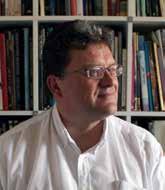
SWPS Magazine is published once a year. Articles are written by students and sta The views expressed in this magazine are not necessarily those of Sir William Perkins’s School.
Design and desktop publishing by Ian Russell and Lizzie Sevenoaks. Printing by G.H. Smith. School Information: Telephone: 01932 574900 www.swps.org.uk
SWPS 1 CONTENTS CO-CURRICULAR Rowing 48 Disection Club 49 Katie Ford FEATURES Head Start 34 Object Lesson 50 Another Perspective 56 Mr Peel's Legacy ARTWORK 30 GCSE 38 A Level SUBJECTS Science 10 History 11 English 13 Modern Languages 16 Psychology 18 Drama 20 Classics 21 Computer Science 22 Geography 32 Music 36 Physical Education 40 Science 46 Religious Studies 52 Modern Languages 54 Economics 57 Food Technology 6 2
2
2 SWPS
dfsd sfvsdfds sdvsdvs
Debbie Picton
head start ??? “ “ ??
BOWING OUT
How much did you know about our Head Girls? Here’s what they have to say about each other

Siona Mistry by Bethan Martin
Siona is the friendliest and most compassionate person I know. I admire her enthusiasm and dedication as she juggles everything from coaching gymnastics to promoting the work of the Art & Design Department. She has never failed to make me smile, particularly with videos of her adorable hamster; her love for animals is unmatched! I have no doubt that she will excel in her future career as a vet.

Bethan Martin by Lucy Beaumont
Beth is one of the kindest people I’ve ever met and the type of person who will already be helping you before you’ve even asked. With a passion for netball, music and science, Beth is an amazingly well-rounded student who excels in virtually everything she does! In the future, she hopes to study a biology-related course like bio-chem or natural sciences. Whatever she chooses, I know she’ll smash it!
Eve Leyland by Siona Mistry
Despite practically living in the Silent Study Room, Eve never fails to surprise me with her perceptiveness, confidence and organisational skills. Her determination to put her whole heart into everything she does has proved to be a huge asset to SWPS as our Head Girl and in relation to her aspirations to study medicine at university. Eve inspires me every day and it has been brilliant working with her this year.

Lucy Beaumont by Eve Leyland
I feel incredibly lucky to have known Lucy for the past seven years. Lucy never fails to have a smile on her face and is always eager to contribute whenever she can. With her admirable dedication and generosity, I know that she will be successful in whatever she does, whether that’s in chemical engineering or pursuing her sidedream of becoming one of Beyoncé’s back-up dancers!

SWPS 3
head
start
co-curricular
R OW I NG
Iona Riley (Rowing Coach) and Chris Boddy (Head Coach) talk to Evie Stockham and Addy Patient (Year 12)

How did you start rowing?
Chris Boddy: I was eleven. I did loads of sports when I was little: football, cricket, rugby; I liked Formula One and I liked watching sports. My brother is eight years older than me, and his school started rowing when he was in the sixth form. He wasn’t very sporty, but he was part of the first group of people who started rowing at the school. I remember being nine or ten and watching a regatta he was a part of, and it being something totally di erent; I remember thinking that I wanted to have a go! In Year 7, I was able to give it a try. It was a year when our Junior 14s won Silver
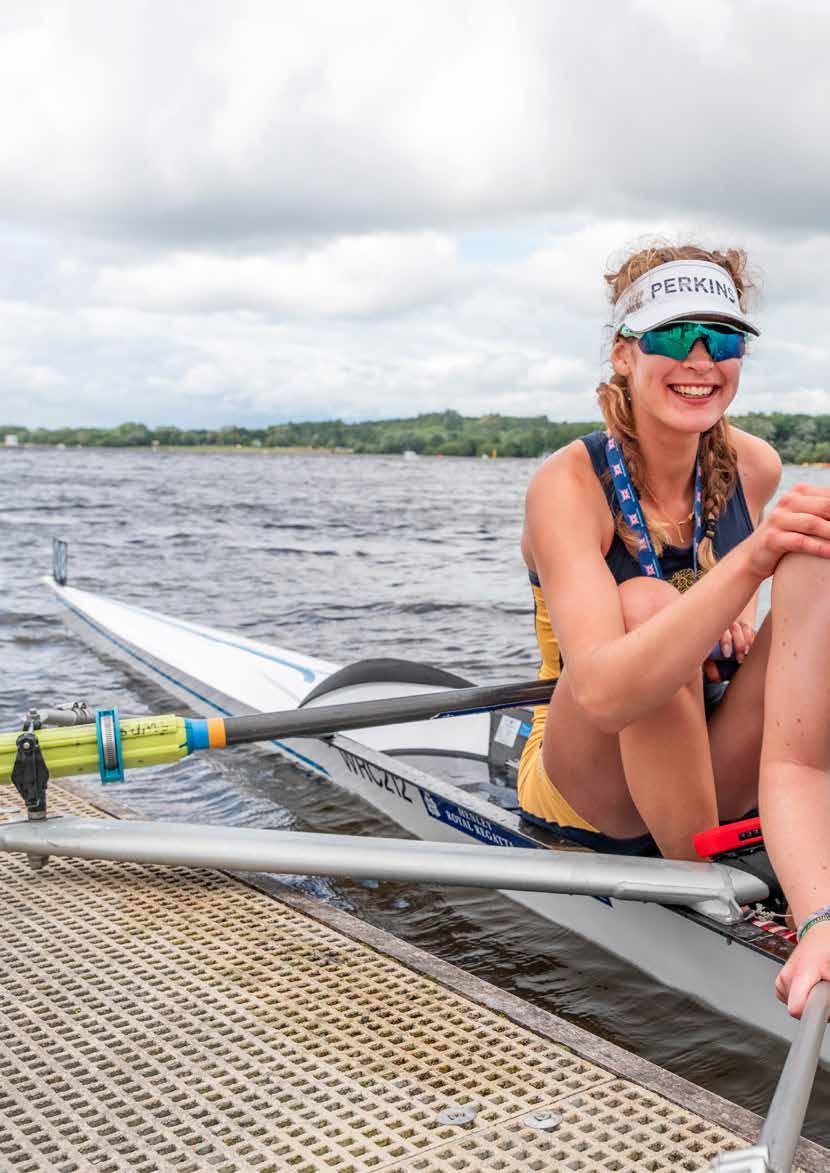
at the Schools’ Head, and we thought, “Oh, this is something we can do, and do well in!” We won BRIT Champs (British Rowing Junior and Senior Club Championships) in J14 and the J16s above us won NAT Schools (National Schools’ Regatta) in a 4+, and that was the school’s first ever Gold. I then liked rowing because we were winning. It felt cool to be part of something in which you are trying to be the best in the country.
Iona Riley: I was eleven years old and I was very sporty at school. My primary school teacher rowed and coached, and he said I could be very good at it because I was very tall. I decided to give it a go. He brought a rowing machine into school and the whole class went on a trip to the boat house. Up until then, my school had only o ered netball and football; I hadn’t known that rowing existed so the chance to row at the local club was really cool.
What do you think of as your greatest achievement so far?
CB: Probably winning a medal at the 2012 Europeans; that was an Olympic year and I had just missed out on being the reserve for the lightweight team, where there were only six seats. I was in a double for the Europeans and it was definitely the best international regatta I’ve ever had. It was the most in-control experience I’d had. I was with a slightly younger guy who needed quite a lot of support getting through it, which meant I was the least nervous I had been. I think it was the combination of my psychology, and my willingness to row as hard as I could to be at the front. We were against some very good people – rowers who had come within the top ten at the Olympics. We hadn’t led in our heat on the first day of the Europeans so
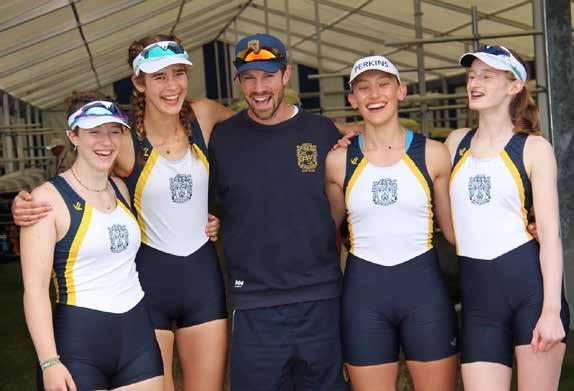
we had to race in the repechage (second-chance heat) later in the day. We managed to get through, but it put us in the outside lane of the semi-final. It wasn’t ideal, but we viewed it from the perspective that, from the outside lane, it’s harder for people to see us. We raced the semi-final and we were so in control. We won! It felt amazing to be in the last 500 metres of the race and find ourselves thinking, “We are going to win”.
IR: Mine is being selected for Great Britain at the Under 23 selection trials. It was a big deal for me, especially as I had to fight so hard for my seat in the eight. The margins in the seat races (on rowing machines) I did were too small to di erentiate between me and the other girl, so we had to do an “ergo-o ”, which was actually good for me because it played to my strengths.
I’m also proud of this achievement because I had to train up in Aberdeen which included lots of flights and I had no individual coach. I’m very grateful for my parents because they supported me with this.
What brought you into coaching?
CB: I didn’t know that I wanted to be a coach. After I left the national team and rowed at Leander for a while, I couldn’t imagine not being involved in rowing. I realised that rowing was the thing in my life that I am best qualified to do, talk about and put into practice. And, I thought maybe I could do something that doesn’t feel like I’m going to work every day! Which is why I started to search for coaching jobs –and SWPS came up.
As a coach, every medal for a crew you have looked after has a story. You know how they got there That is amazing. For example, watching Anna Cowell race in Spain and seeing her stand on a podium with the National Anthem playing was incredible. I was never good enough to have that experience and seeing someone do that who you have worked with every day was really cool!

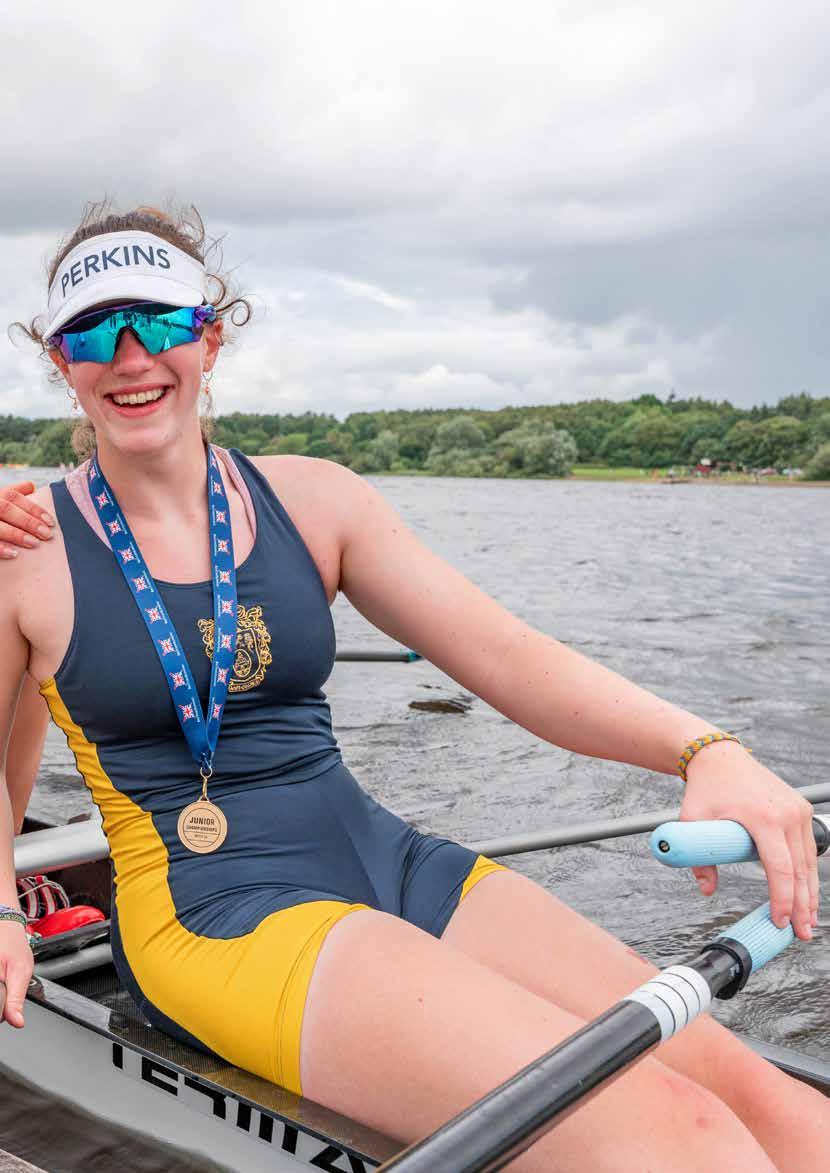
IR: I always knew I’d go down the sporting route because I’ve never wanted to have an o ce job. I helped out at coaching from an early age and I find it rewarding because it’s great to be able to pass on my experiences and love of rowing. My main aim, while I’m coaching at SWPS, is for there to be a winning culture. I want SWPS to be one of the frontrunning schools who are consistently at the top with the winning team.

On the 2nd of February 2023, I attended a lecture given by Chris Brockley-Blatt, Senior Project Manager at The Mullard Space Science Laboratory (MSSL) who worked on part of an in-situ device on the Solar Orbiter and is now working on the Euclid VIS Instrument. The lecture was held at the University of Surrey by the Guildford Astronomical Society.
SOLAR : AN ENGINEER’S STORY
The Solar Orbiter is a space telescope built to study the sun. It is an international project, with over 2000 people who have worked and are still working on it. Both the European Space Agency (ESA) and the National Aeronautics and Space Administration (NASA) are involved, with the addition of numerous universities and organisations world-wide, each with a range of responsibilities for the ten di erent instruments on the probe. Its mission is to explore parts of the sun that have never been explored and record data that has never been recorded.
This had never previously been attempted. After being launched, the orbiter will start out with a circular orbit around the sun which will eventually turn into an elliptical orbit, but not going any further out than the Asteroid Belt. The probe’s orbit will gradually become more and more inclined to the plane of the solar system in order to be able to see the very North and South poles of the Sun. What happens at these poles is unknown as it is impossible to see the very North and South of the Sun from Earth. The data that will be collected will be nothing like we have ever seen and will provide us with a greater understanding of the closest star to us.
The Solar Orbiter consists of seven telescopes and three in-situ instruments similar to the devices that collected data from Mars’ surface. Although every instrument and telescope are extremely interesting, the focus of this article is part of the Solar Wind Analyser (SWA) called the Electron Analyser System (EAS).
The SWA is an in-situ device with four main parts in three di erent locations; EAS, mounted on the end of a long pole, the Heavy Ion Sensor (HIS), the Proton and Alpha Particle Sensor (PAS) and the data processing unit (DPU), positioned in two di erent corners behind the heat shield. The heat shield is coated with a special paint made from animal bones as it provides the best protection from strong solar
radiation that the probe will be exposed to in space when not protected by the Earth’s magnetic field. The heat shield is an important component as the electronics behind it need to be kept at 40-55°C, as the part of the probe facing the sun reaches temperatures of up to 500°C and the part facing away from the sun can reach temperatures as low as -269°C.
The Mullard Space Science Laboratory (MSSL), which is part UCL, leads the EAS project and the Laboratoire de Physique des Plasmas (LPP Paris) built the hardware for the device. On two sides of the instrument, pointing at 90° away from each other, there are sensors which measure electrons. As electrons are blasted out from the sun, they enter the device through a mesh protection which blocks out harmful types of radiation, inside the mesh layer there is a positively charged plate which the electrons are attracted to. This charged plate is one big sensor which measures the velocity of electrons when they hit the plate. After the sensors receive the data, the information is sent to several circuit boards, first to a transformer, next through the programming board, then to a DC converter and finally to the motherboard that records all the information and sends it back to teams on Earth who sort through the data.
After the mission had been selected in 2011 by ESA, the team making EAS in MSSL made a prototype to make sure the principle of the machine works. They had to test it physically and through simulations, by heating it up to high temperatures then cooling it down, as well as forcefully shaking it, to simulate the rocket launch. Then, they tested it to make sure the device would respond as it should when an electron hits the sensors. Next, they built a
6 SWPS science
solar
Wordsby GraceBurt h
ORB RETI
flight model (an exact copy of the instrument that is later installed on the space craft). They again thermally tested EAS while connected with the rest of the SWA test model. Finally, it was ready to be shipped o to be attached to the rest of Solar Orbiter which was being assembled by Airbus. Once assembled, it was shipped to NASA where every system was rigorously tested again and finally was launched into space on the 9th of February 2020.
The Solar Orbiter is currently in its orbit at about 42,000,000 km away from the Sun and 33° above the solar equator. It has taken images and recorded data unlike anything we have previously taken or recorded. The mission has been a huge success and our understanding of the sun has already greatly improved. For more information about the Solar Orbiter, you can visit: https://www.esa.int/ Science_Exploration/Space_Science/Solar_Orbiter.
I found the talk hugely inspirational and will always remember something the speaker said at the end of the talk in answer to one of the questions asked. One of the audience members asked: “How did you guarantee EAS to work as designed?” to which she replied that they already “knew all the problems” through such thorough testing over 9 years of work and that it was only a matter of “changing little bits at a time” to keep improving the design.
I feel that this method of “changing little bits at a time” to keep improving, is something that can be applied to not only aerospace engineering but to everything we do in day-to-day life.



SWPS 7
Artworkby W i l wol eHf namre Y( e
12)
orbital
a r
mo raeY( )11
the chemistry of cosmetics throughout history
Eve Leyland and Siona Mistry (Year 12) investigate
chem. in cosmetics
Ancient Egypt: c. 3100 B.C. - c.300 B.C
Although 5000 years ago seems very unfamiliar, the Ancient Egyptians enjoyed enhancing and accentuating their best features just as we do today. The most distinctive cosmetic used was Kohl, made from black lead (II) sulphide and oxidised copper mixed with oils. This eyeliner-like substance was perfect for achieving the famous Cleopatra look and preventing eye infections; however, it was highly hazardous due to its carcinogenic and damaging properties. Green malachite (copper carbonate) eye paints were also used underneath the eye; malachite
is an ore of copper and therefore an irritant. There is scarce evidence of the e ects of these products on Ancient Egyptians, yet we do know their anti-bacterial properties limited infection, and thus made the paints more popular.
Indigenous Americans
One of the most famous civilisations known for war paints are the Indigenous Americans. They produced various colours from naturally occurring minerals, such as hematite (iron oxide). After crushing hematite into a powder and mixing with bear fat, the striking red paint could be applied to the skin. As an antioxidant, this helped to protect the skin against UV radiation from the sun: exposure to sunlight increases the number of damaging reactive oxygen and nitrogen species on the skin, which in turn aids the breakdown of collagen and elastin. The application of the red paint decreases oxidative stress (in other words, the overload of oxidants causing chronic inflammation of skin) which provides a multitude of health benefits: so much so, that iron oxide pigments are still being used today!
Elizabethan Era
This era in history brought with it the continued use of lead-based whitening makeup. Lead’s toxicity is primarily due to binding with sulfhydryl groups of enzymes and displacing metal ions from their appropriate biochemical reactions. One of the several enzymes poisoned by lead is responsible for the production of heam groups (which are vital for the function of red blood cells); therefore, due to the inability for these heam groups to be produced, anaemia (lack of oxygen delivery by red blood cells) is often a symptom of lead poisoning. One notable figure who is believed to have su ered from this condition was Queen Elizabeth, whose pale complexion was achieved using a makeup known as Venetian ceruse. Unbeknownst to people at the time, this makeup contained a dangerous proportion of lead and through constant use, led to blood poisoning.
8 SWPS science
chem. in cosmetics
Modern Era
An alarming 2022 study found that those who regularly use heat protectant products and chemical hair straighteners were almost twice as likely to develop uterine cancer. Researchers believe that these particular hair treatments contain endocrine disruptors (chemicals which increase the amount of oestrogen in the body). The peak of the hormone oestrogen often characterises early-stage uterine cancer because of the e ect it has on thickening the endometrium. Furthermore, keratin hair-smoothing treatments were discovered to contain formaldehyde (or chemicals which reacted to form formaldehyde upon heating). This is a carcinogen (a substance which causes cancer), hence the developing correlation between uterine cancer and inhalation of formaldehydes.
The health regulations of cosmetics have come a long way since Ancient Egypt and the Elizabethan era. However, we are currently witnessing a cosmetics revolution where companies are seeking more innovative products alongside cheaper manufacturing, leading to more harmful chemicals appearing in our everyday cosmetics. The repercussions of this mean that consumers, and even those working in the cosmetics industry, are becoming increasingly unaware about the risks that their products pose – luckily, this risk can be determined with the help of chemistry!
Artwork by Amy Li (Year 11)

CuCO 3 PbS
Fe2O3
history
the birth of feminism
"We hold these truths to be self-evident that all men and women are created equally" began the Declaration of Sentiments, introduced by Elizabeth Cady Stanton at the Seneca Falls convention in 1848. Held from July 19th to 20th in New York, the Seneca Falls Convention is recognised as the first women's rights convention in which the foundations for the feminist movement were laid, the movement that still fights for women’s equality in society to this day.
The convention was directed by Elizabeth Cady Stanton and Lucretia Mott, who met at the World Anti-Slavery Convention eight years prior. Despite women being allowed to attend, female attendees were prohibited from talking or voting. This enraged the two women and led to a resolution between Stanton and Mott to create their own conventionone which focused solely on the rights of women. Women’s rights were a divisive issue in 19th century society as many saw no point in creating movements for change. The reduction of women to their roles as mothers and wives was a normalised aspect of society, and the law created restrictions in areas such as education, marriage and the workplace. However, this was challenged when Mott visited New
of grievances and resolutions that called for women’s equality in law. It was modelled on the Declaration of Independence to highlight the contradictions between the points made in the Constitution and the realities women in the USA faced at the time.
The first day of the convention was open solely to women, with men being allowed to attend the second day. Over the course of the two days, attendees heard, discussed, and ratified the Declaration of Sentiments. The declaration began with 19 grievances about the treatment of women that were believed to "lessen [a woman’s] self-respect, and to make her willing to lead a dependent and abject life”. Stanton used the grievances to emphasise the injustices faced by women, which included the inability to own property or even have legal claims over their children. This was followed by a series of 11 resolutions calling for the destruction of gender inequality in society. Almost all of the resolutions were readily agreed to, with the exception of the 9th resolution, which demanded the vote for women. Impassioned and convincing speeches were given in its defence by Stanton and African American abolitionist Frederick Douglass who argued that due to their inability to vote, women were being subjected to laws that they did not consent to. The resolution was eventually passed. Despite some attendees withdrawing their support due to the controversy of the 9th resolution, the issue of voting rights became a crucial element in the feminist movement that progressed into the 20th century.

The event gained national fame and received mixed reactions from the public.
Many criticised the movement and ridiculed those in attendance, however, Stanton viewed the fame as celebratory: “it will start women thinking, and men too; and when men and women think about a new question, the first step in progress is taken”. And so, the first step was taken. The events of the convention catalysed the formation of the su rage movement, which resulted in the 19th Amendment securing the vote for women in 1920. Stanton and Mott are just two of the many women who paved the way for others, such as Emmeline Pankhurst and Gloria Steinem, to further the feminist movement, which today is one of the largest equality movements continuing to fight for the rights of every woman across the globe.
Graham (Year 12)
Words by Eimer
Artwork by Gia Sandhu (Year 11)

SAPPHO'S INFLUENCE ON ROMANTIC POETRY: english
Words by
Artwork
by Ava-Mae Martell (Year 11)
Many know the name of Sappho, whether that be from the term “sapphic” or from the iconic poems. She is renowned as the poetess (much like Homer is renowned as the poet) and praised as “The Tenth Muse” by Plato.
But why these songs of praises from ancient philosophers and modern poets alike? The fact that she is still remembered up to modern day says enough, but her influence is still seen in romantic poetry and in some cases even tragedy and letters.
For one, Sappho was no epic poet, unlike the previous poets at the time – quite the opposite. With the fraction of poetry we have, she was moved by her own desire, particularly with the Goddess Aphrodite. This is not like the borderline flirtatious relationship between Odysseus and Athene, but something a lot deeper and more heartfelt. The woman even calls herself “Love-demented Sappho” in her Ode to Aphrodite (Homer could never). While this does seem self-explanatory, you may interpret this as being devout to a Goddess and simply being in love with someone else. However, in the same poem, Sappho says “Yes, if she soon does not know about love, she will soon love unwillingly.” I do not know about you, but there is simply no platonic way to explain that.
Just want to add that this is hyperbole and remind everyone not to force your crushes to love you.
One of the earliest examples of Sappho’s influence is seen through the lovesick perspective of Catullus, one of the first Roman poets. Seeing that he took a lot of Hellenistic influence in general, it is no surprise that she was one of the poet’s own muses; in Poem 51, Catullus is sulking watching his lover, Lesbia, dote on another dumb hunk. Catullus is seen to take influence from Sappho’s poem in his structure, using the sapphic stanza as some may call it. To summarise: this has four lines in it and a long-short-short pattern and – obvious by the name - is frequently used in Sapphic poetry. This is also used by later poets such as Lord Byron, George Gordon, and Alfred Tennyson. So, for all you poetry nerds, that’s how Sappho structurally influenced poetry.
Even Shakespeare may have been inspired by Sappho, especially through his love for the classics. In

a lot of love poetry, the “star crossed, ill-fated lovers” trope is common; a common theme in his plays, this is Shakespeare’s speciality. However, the lesser-known Sonnets (1609) - whilst Shakespeare is not directly associated with Sappho - seem to hold that same desire seen by Sappho and other Hellenistic love poets, especially sonnet 18, which will ring a bell for some English nerds (Hello Dr Ashraf). Shakespeare describes “his gold complexion dimm’d;” I found this a parallel to how it is frequently rumoured how Sappho is talking to a woman in sonnet 31, using alliteration such as “sweet speaking”. Seeing that Sappho is renowned as giving “a subjective experience” to love, this does show her influence in describing love.
Around 116 sonnets are dedicated to this young man (presumably more upper class than Shakespeare), like Sappho’s obsession with her muse. Shakespeare describes a “master-mistress of my passion” in Sonnet 20. This seems a bit more ambiguous than Sappho because it does imitate that conflicting feeling Sappho has in her poetry. I thought this was reminiscent of the fragment in Sappho calling Love “A creature bitter-sweet, ba ing” – this keeps the same gender-neutral language as Shakespeare, which leads me to believe that Sappho did lead some ambiguity in sexuality.
Disappointingly, however, we only have fragments of her poetry. Most modern scholars do not know how it got so destroyed, but I simply find it fascinating that her influenced has even gone beyond the terrain of poetry and into letters, plays and even embedded in historical texts. Even in her time, according to the poet’s collection, she was criticised and some of her poems were even thrown in the fire. Her poems are still debated today, including on sexuality and on her influence as a Greek lyric poet, which is why she is so interesting as an individual with how not only her poetry but also (and forgive the cliché) is shrouded in mystery.
Before this article ends, it is a fitting end to say how national poetry society describes Sappho's influence as “The Romantic idea of a poet as a creature of feeling, one whose solitary song is overheard.”

SWPS 11
the planets poetry competition a short poem
Aurora skies
Illustrated by the painter Of shadows and light
Create a majestic curtain for the Glistening stars of the operation.
Greenery so dense
That paths of darkness
Weave desperately through; painting veins of nightfall onto the soil underneath.
Red grains of nothingness
Waft in waves, stirring restlessly Forming soaring, pointless peaks, Created to be destroyed.
Yet deep within these impossible Floating spheres, Lurks a fear of an ending…
A slow trembling can be felt, An anxious beating of a heart, The knowledge of a possible Sudden crash, explosion, combustion.
The planets seem to breathe together Slow sighs of acceptance
As their bright, fiery enemy Becomes unstoppable. A crash and A cry and A blinding light and Silence.
This ending Is too magnificent to be seen For there are no eyes left To watch the destruction.
The painter of the skies Is left without colour. Now the dark blanket of night must brave the fight with the memory of light.
12 SWPS english
Maya Daniel (Year 12) Artwork by Milly Wee (Year 13)
written by
WOM€N in work in G€RMANY
By Emily Fletcher (Year 12)
Throughout history, the roles of women have changed globally, mostly for the better. Specifically in Germany, there are more women in employment than ever before, and an increasing number of women working in leading roles. The former chancellor, Angela Merkel, is a huge inspiration: she became the first and, so far, only female chancellor of Germany, who served for 16 years. She also received the UNESCO Peace Prize for her refugee policy and has made a hugely positive impact in Germany.
However, in Germany there is still a gender pay gap, as with many other countries. This is largely due to di erences in career choices, with many women working in lower paid professions and industries. There is also a higher chance that women work part-time or for reduced hours, especially if they are single mothers (Alleinerziehendemütter), with childcare responsibilities. But after the major e ects of the global pandemic, things are hopefully looking up in the working world, with more single parents managing better financially and with an increased availability of childcare services (Kinderbetreuungsdienste).
According to the General Equal Treatment Act (das Allgemeines Gleichbehandlungsgesetz), which was passed in 2006, everyone is considered to be equal in Germany. But, even though a large percentage of women have the same or higher education and qualifications as their male counterparts, there are still very few women at the highest executive levels in Germany.
Nevertheless, in terms of gender equality in Germany, there has been great progress. Since reunification in 1990, the proportion of working women has increased by fifteen percent. Even so, the country wants to e ect greater change and therefore the German government has established two goals regarding gender equality: to reduce the gender pay gap from 18 percent in 2021 to ten percent in 2030 and to raise the prevalence of women in leadership roles to thirty percent by 2030, from the current level of about 24 percent. These goals could be challenging to attain, but would bring about drastic improvements to the lives of women in the country.
€ € € € € € € € € € € € € € € €
€ € € € €
SWPS 13 modern languages
€
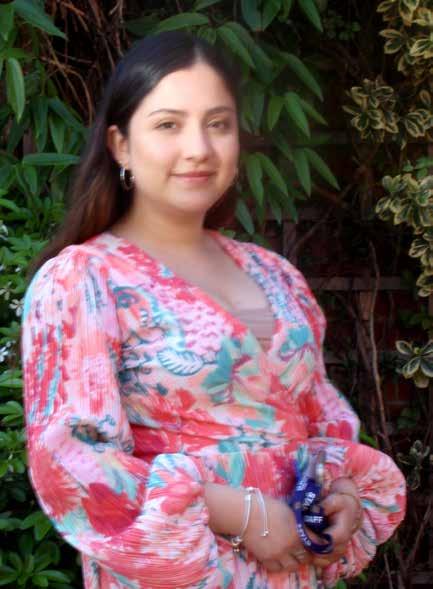
Tell us something we should defnitely know about your country
Yo soy de Ecuador, entonces, algo interesante es que nosotros estamos en la mitad del mundo. Hay un lugar donde puedes poner qualquier cosa, un lapiz, un clavo, lo que tú quieras. Se llama la mitad del mundo y puede estar oficialmente en la mitad del mundo. Es algo muy interesante y lo puedes visitar.
Ich würde sagen, dass die Deutschen manchmal ein wenig grummelig oder vielleicht unfreundlich
auf manche Ausländer wirken. Dabei sind wir meistens einfach sehr fokussiert auf unsere Arbeit und wir sind nicht oberflächlich. Und was ich schön finde ist, wenn wir erst einmal richtige Freundschaften knüpfen, dann sind diesen oft sehr aufrichtig und sehr echt und halten ein Leben lang. Das finde ich sehr schön über uns Deutschen.
What’s the most surprising thing you’ve learnt about England?
El invierno ha sido muy fuerte. Mas de lo que me imaginaba, han sido tres meses. Bueno en mi país no tenemos invierno, es un clima tropical todo el año. Todo el año el sol sale a las seis y se pone a las seis. Entonces, en invierno cuando el sol salía a las ocho y se ponía a las tres de la tarde, fue muy sorprendente para mi. Y otra cosa es culturalmente aquí la gente te dice ‘are you okay/alright?’ y tú piensas, me veo mal? Pero es una manera de decir ‘como estás?’. Pero nosotros decimos ‘como estás?’. ‘Estás bien?’ es como para preocuparse, como tú no te ves bien. Pues eso, son las diferencias culturales.
Ich habe sehr lange über Nacht gedacht und ich glaube, es sind die sehr hohen Lebenshaltungskosten. es ist alles etwas teurer hier als ich zuvor gedacht hatte und es war ein erste Umstellung von Deutschland. Zusätzlich unterscheidet sich das englische Schulsystem doch sehr von dem Deutschen.
What’s your favourite English word?
Hay una palabra en Ingles, Serendipity, que es como un suceso inesperado bueno que te pasó. Me gusta mucho esta palabra porque siento que esta experiencia es eso. Es un suceso inesperado. Y tambien esa palabra, no tenemos
TALKING IT OVER
Before their time at SWPS came to an end, Paula Pinto and Laura Demann, our Spanish and German Assistants, sat down with Larisa Oliver-Warman and Emily Fletcher (Year 12), for a bit of conversation
14 SWPS
una traducción como tal una palabra en español que yo haya podido pensar. Es una palabra muy bonita, muy especial.
Ich finde ‘Bumblebee’ und ‘Honeymoon’ hören sich beide total süß an! Aber ich habe mich für Business entschieden, denn es ist ein sehr starkes und gehaltvolles Wort, bis ich es mir im Kopf mit deutscher Aussprache buchstäblich aufsage, um es korrekt aufschreiben zu können. Das wäre nämlich ‘boo-zi-ness’ - und es hört sich auf Deutsch witzig auf!
Which food from your country would you recommend?
A nosotros nos gusta mucho el plátano. Entonces cocinamos mucho con eso. Mi plato favorito ecuatoriano se llama bolón de verde. Esta hecho con plátano maduro y plátano verde que es salado. Entonces es un plato salado. Tiene también carne, queso y lo puedes comer con un poco de paprika que le da mucho sabor y es muy muy delicioso. Tambien con huevo frito se puede comer para el desayuno.
Ich liebe zur Herbstzeit, wenn es langsam kalt draußen wird , Grünkohl zu essen, – frischer Grünkohl mit Speck, Kohlwurst oder Bratwurst und Karto eln, Spiegelei und Senf – das ist mein lieblingsessen.
Who or what inspires you?
Me inspira mucho mi familia en general, mis padres, mi hermano. Siento que puedo aprender mucho de mis padres, de mi madre, de su ejemplo, de su valentía. Y también pensar en ellos, hacerles sentir orgullosos de mi y lo que hago y que se sienten alegres por mí es algo que me inspira todos los días, algo que me pone contenta y tambien que me motiva a hacer buenas cosas y seguir avanzando.
ich glaube, ich habe meine kreative Ader und mein Selbstbewusstsein von meiner Oma geerbt. Meine Oma erzählt mir heute noch, dass ‘man im Leben alles erreichen kann, auch ohne einen Mann’!
What are your plans for the future?
Bueno, esta semana terminó mi paso por Sir William y tengo algunos planes pero no estoy muy segura. Por un lado me gustaría estudiar para ser profesora de español aquí en el Reino Unido. O también me gustaría seguir con mi carrera de psicología y hacer una maestria en psicología infantil. Tengo esas dos oportunidades y tengo que tomar una decision.

Ich habe mich für meine Oma entschieden, weil sie sehr früh und sehr jung eine alleinerziehende Mutter war und trotzdem hat sie Karriere gemacht. Das fand ich sehr beeindruckend und
Zuerst werde ich eine neue Wohnung mit meinem Freund einrichten, in die ich in ein paar Tagen einziehe. Danach habe ich den Sommer frei, die ich kann meinen Sommer genießen und dann werde ich im Herbst mein Referendariat als Englisch- und Kunstlehrerin für das Gymnasium in Deutschland beginnen.
SWPS 15
modern languages

 Words by Bethan Martin (Year
Words by Bethan Martin (Year
12)
detect ing deception
Lie detection has always been a very controversial topic and there are endless websites and videos claiming to have nailed the method for detecting deception. The most well-known lie detector is the Polygraph. The Keeler Polygraph, which was the first ever, was initially used in 1935. Since then, the polygraph has been used worldwide in criminal investigations and is used in the UK by the National O ender Management Service to help aid decisions about early release for specific crimes. Although the Polygraph is used in the UK, it cannot be used as evidence in court as, despite its name, it does not detect lies or even reliably indicate that a suspect may be lying. So, does the polygraph even deserve the name of the lie detector test?
The polygraph measures three di erent things: cardiovascular response (heart rate and blood pressure), electrodermal response (sweating) and respiratory response (breathing).
Research has shown that lying is usually accompanied by an increase in heart rate and blood pressure, therefore a polygraph examiner will look for this on the graph that is produced. However, some studies have proved that as the volume of sweat you produce increases (even in miniscule amounts), your heart rate decreases. Raised heart rate and blood pressure are also signs of nerves, stress, or overthinking. While it is often accompanied by guilt, the suspect may not always feel guilty, making this an unreliable source. It is also possible to lower or raise your heart rate by thinking of other things – this is a technique which is commonly used by criminals.

At the beginning of the polygraph test, a series of baseline questions are asked to determine the suspect’s average response scores. Results are only recorded for the first five seconds after the question has been asked. This is because we speak at a rate of 125 to 150 words per minute and it is thought that we think ten times faster than we speak. As a result, we can conclude that the response in the first five seconds is a reaction directly to the stimulus – the question – but any results afterwards are more likely to be unrelated or perhaps deliberate actions to fool the examiner, such as consciously slowing down breathing rate in order to decrease heart rate.
It is thought that looking at the electrodermal response is more accurate. This is because, while hormones such as adrenaline can control your heart rate, skin conductance (sweating) is only regulated by the central nervous system, and not controlled by your brain. However, this is also unreliable as you can produce this response using other methods such
16 SWPS psychology
literally biting
“

detecting deception
as putting a pin in your shoe (as seen in films such as Ocean’s 13) or literally biting your tongue. Using these methods on control questions will increase responses on baseline readings, therefore when lying, responses will match up with the deceitful baseline. In addition, hormones such as adrenaline are produced when lying, which are known for increasing heart and respiratory rate, but adrenaline can also be produced
when you are feeling anxious or under pressure. In conclusion, despite lie detector references in entertainment, a polygraph examiner ultimately cannot say categorically that a person has lied, only that they have displayed indicators of stress. So, there is no such thing as a lie detector and a polygraph does not detect lies.

 Artwork by Ashury Warnes
Artwork by Ashury Warnes
(Year 11) “ your tongue

Riya Vyas (Year 12) used to think of herself as shy. So how did she end up performing on a West End stage?

At the age of six, I started attending a local Stagecoach drama school. I was a really shy child, in almost every environment I found myself in, so this was intended to help me develop my self-confidence.
After a while, though, that initial objective grew into something else. I developed a passion for singing, dancing, and being engrossed in a script. I quickly realised that
I wanted to continue performing on stage; theatre began to feel like a second home and a place where I could freely express myself.
In 2016, I was cast in my first professional role as The Little Girl in Ragtime at the Charing Cross Theatre! Being just ten years old, this opportunity truly opened my eyes. I already had a love of acting, and an appreciation of musical theatre, but this gave me the experience of being part of a cast and seeing everything that happens backstage to make the show what it is. I was astonished at how a group of actors could tell such a beautiful story while playing instruments on stage (replacing the traditional band in the pit), and singing and dancing as well! From the first day of rehearsals, to taking my very last bow, that experience of being on a stage and performing to a live audience made me realise that this was something I wanted to do, again and again!
When I received the phone call from my agent... I cried!
The audition process can be a tiring one, especially for child actors who must balance the commitment required with their academic studies. As well as the countless rejections, there are lots of late-night rehearsals, and learning of lines within very short timeframes. Yet, being given the opportunity to perform on stage to a packed audience, night after night, makes every struggle seem worth it.
Following my performance in Ragtime, I joined the Sylvia Young Agency and took part in their summer shows. A highlight was playing Sandy in Grease. I
“ “
drama
successfully auditioned to be a member of the youth theatre – Rose Young Company – at the Rose Theatre in Kingston, where I performed in a number of their shows. I was determined to make the most of every opportunity and take the advice of the directors I have met, which is to go for everything!
Pandora... is confident, bold, and a complete feminist
In 2019, I was lucky enough to make my West End debut as Pandora in The Secret Diary of Adrian Mole Aged 13 ¾ at the Ambassadors Theatre. I even managed to finish the run before the lights in the West End were switched o during the pandemic. The audition process was tough and extended across
five rounds. Over a thousand people auditioned. I kept telling myself to just do my best. I remember feeling that it was partly going to come down to luck! More often than not, that is very true. Even so, I knew I was really hoping for a successful outcome to my auditions. When I received the phone call from my agent, telling me I had been cast, I was so overwhelmed I cried tears of joy!
Pandora was a role I felt very connected to, as she is confident, bold, and a complete feminist.
My top three favourite moments in Adrian Mole were: the first rehearsal where we met the whole cast and did our first ever script read-through, the press night, and the emotional final performance!
The whole experience flew by very quickly. It is definitely something I will always remember.
I am currently part of the National Youth Theatre Company and am excited about the memories yet to be made.
I love theatre because the people you work with feel like a family, and along the way you get to have tons of life-changing experiences and make so many amazing memories. And, I really believe that the resilience and commitment you have to develop will pay o in the end.


drama
“ “
DID THE TROJAN WAR ACTUALLY HAPPEN?

The Trojan War, unless you’re a Classics student, your main knowledge about it probably resides in that Big Ole’ Horse the Greeks used to defeat the Trojans inside the walls of Troy. As much as I would adore to regale you beautiful readers with an in-depth analysis of the Trojan War, the electrifying question I will be answering today is: Did it actually happen? And the answer is, essentially, kind of.
Let’s begin with the mythos and what was generally believed by the Ancient Greeks. To summarise, the goddess of beauty Aphrodite was chosen by the Trojan mortal Paris as the most beautiful; antagonising not one, but two other goddesses. In return Aphrodite gives him (the happily married) Helen of Sparta. Her husband, notably infuriated, declares war on the Trojans with each prior suitor of Helen fighting on his side. Then, a ten-year long war ensues with an abundance of misery and neither side truly emerging as a victor. Fun times!
Now, from an Ancient Greek perspective, the mythology of their gods was believed to a great extent, as was this mythical tale of the Trojan War. In the present day, however, we are a little more sceptical and very keen to know the actual events.
“As Troy is based in modern-day Turkey, it would make sense to start there.” said amateur archaeologist Heinrich Schliemann in the midst of a mid-life crisis and began digging at the Turkish town Hissarlik in 1871.
Assuming that Troy would be at the lowest level of the archaeological site, Schliemann managed to destroy almost all traces of the city he’d set out to find. Well done, Schliemann.
However, amongst the nine cities he did find, modern historians agree that ancient Troy was indeed found in Hissarlik. Well done, Schliemann!
This brings us to the question I am meant to be answering: Did the Trojan War happen? Evidence of warfare in Hissarlik consisting of scorch marks and the discovery of arrowheads that corresponds to the period of Homer’s Trojan War is certainly convincing. Reality tells us there was a conflict, but a war as hefty as what is described in ancient texts is probably based on myth and myth alone.
What we can gather from more recent excavations is that Troy was a significant Bronze Age city that dates back to the 12th century BCE. The charred debris and scattered skeletons are evidence that the city was destroyed during wartime. We can assume that this annihilated city is the setting the Trojan War is based upon.
If the Trojan War happened, it is likely it didn’t last the ten years that Homer suggests. What we do know is that a conflict did occur, and with it, tragedy.
It also brought an exhilarating epic poem that we can read and study. Are we, the modern perspective, the real victors? Who’s to say.
Words by Laura Latifaj (Year 13)
Artwork by Lucy Anderson (Year 12)
20 SWPS classics
ALGORITHMS, are they running our lives?
What is an algorithm? A dictionary definition would be “a process or set of rules to be followed in calculations or other problemsolving operations, especially by a computer”. Most people associate algorithms with computing; however, algorithms play a key role in our daily lives, from a simple google search to the route an amazon driver takes to deliver parcels.
There are many di erent uses of algorithms in our lives, and we use them every day at school, whether that is planning how to organise homework or revising for exams. In order to be productive, you must use some sort of algorithm. There have been several studies conducted to try and find the most e cient algorithm. One that most people usually follow is the Earliest Due Date first. You probably do not need computer science to tell you that this is a suitable strategy, but computer science does prove that this is the optimal strategy. However, this is assuming you are only concerned about getting the work done and ensuring it is not late, rather than producing the best quality work. Despite being the optimal strategy, it is far from perfect. If you get behind on one piece of work, everything else su ers a result. The key reason for this is procrastination.
Procrastination in itself can be classed as an algorithm. Obviously, it is not a very productive one, and is often described as a “faulty algorithm”. However, it may be considered an optimal solution, just to the wrong problem. Typically, procrastination is associated with laziness and avoidance behaviours, but it is possible for a person to procrastinate and still be productive. Putting o big pieces of work to complete trivial work which still needs to be done but is of lesser importance is an example of this. You could complete four hours of work and seem to get through a lot of work, but you still have that big project looming over you. This is also procrastination. You may be thinking, “what has this got to do with algorithms?”, but there is an algorithm called the Shortest Processing Time algorithm, which exactly reflects this situation; doing the quickest task you can first. It can allow you to get things done and shorten your to-do list, but it is not very e ective when tasks are not of equal time weighting.
Another key issue with the Earliest Due
Date algorithm are interrupts. They are a large part of processing in the CPU and are always dealt with before moving onto the next processing cycle. The same thing happens with humans. Whether it is in the form of someone physically coming and speaking to you or on a mobile phone, it is a distraction taking you away from the task at hand. There are many methods that combat this, such as the “pomodoro” where you work for 20 minutes straight and then break, repeating the cycle. These are also created using algorithms, accounting for the length of time a person can be productive for without zoning out or getting distracted. Operating systems use this same principle, working out how often it needs to check for user inputs without seeming slow or jittery. It is a balancing act which computers have mastered with the use of algorithms, and one that can be applied to our day to day lives as humans.
Algorithms and humans may seem like an odd juxtaposition as for most people when they think of algorithms they think of complex code and machinery. This is not the case; an algorithm is simply a sequence of steps carried out one after another. Following a recipe or building flatpack furniture from instructions are everyday instances of algorithms, and they are used in everyday life all the time. This brings with it the question, is our life defined by algorithms, and is the key to being successful simply picking the right one?
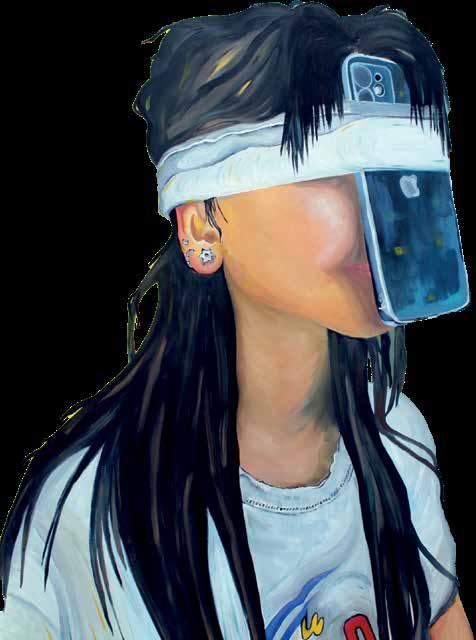

SWPS 21
science
computer
Words by Charlotte Duggan (Year 12) Artwork by Sarah Solimon (Year 11)
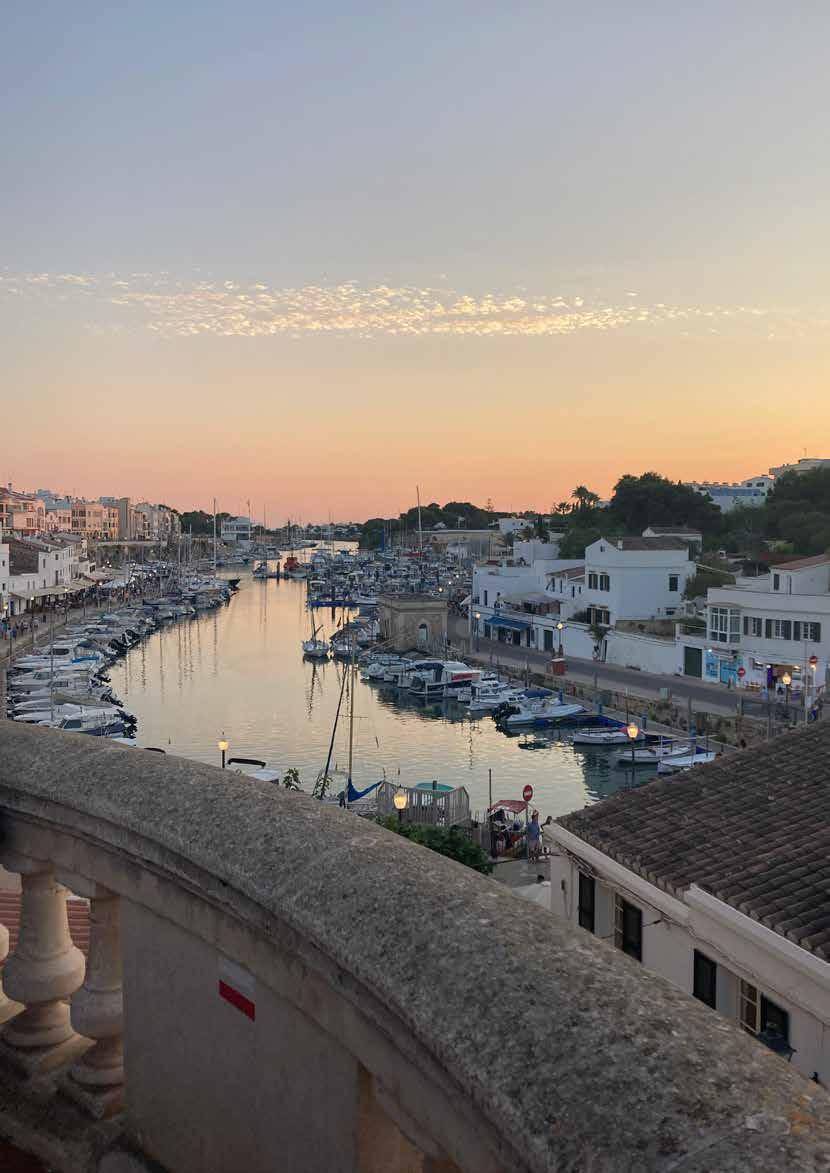
PHOTOGRAPHY TRAVEL
As always, the standard of entries for our competition this year was extremely high. First Prize went to Ashbury Warnes (Year 11) for her beautiful, atmospheric pictures of Vietnam (opposite page). Second place went to Isabelle Franklin-Moseley (Year 7). The other students’ photographs featured on these pages were all Highly Commended.
geography
Minorca by Emily Richards (Year 9)


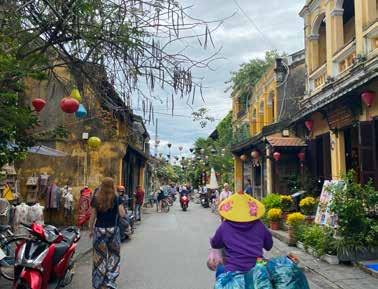

 Vietnam by Ashbury Warnes (Year 11)
Vietnam by Ashbury Warnes (Year 11)


 Top left: Isle of Wight by Emily Richards (Year 9). Top right: Puy-l'Évêque, France by Katie McCummiskey (Year 9)
Above: Lake Moraine, Alberta, Canada by Isabelle Franklin-Moseley (Year 7)
Top left: Isle of Wight by Emily Richards (Year 9). Top right: Puy-l'Évêque, France by Katie McCummiskey (Year 9)
Above: Lake Moraine, Alberta, Canada by Isabelle Franklin-Moseley (Year 7)

7)
Helmcken Falls, British Columbia, Canada by Isabelle Franklin-Moseley (Year

 Top: Lysebotn, Norway by Bella Chen (Year 10)
This picture: Brecon Beacons, Wales by Sienna Balderson (Year 10)
Top: Lysebotn, Norway by Bella Chen (Year 10)
This picture: Brecon Beacons, Wales by Sienna Balderson (Year 10)



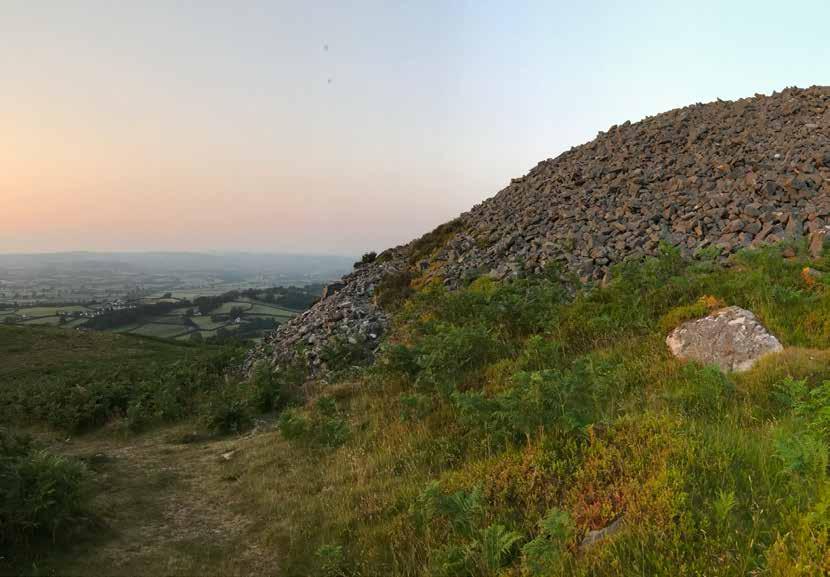 Top left: Printemps Penthouse, Paris by Madison Fordyce (Year 12)
Top right: Trebah Gardens, Falmouth by Akriti Simha (Year 11)
Middle right: Polyapes Campsite, Cobham, Surrey by Katie McCummiskey (Year 9)
Top left: Printemps Penthouse, Paris by Madison Fordyce (Year 12)
Top right: Trebah Gardens, Falmouth by Akriti Simha (Year 11)
Middle right: Polyapes Campsite, Cobham, Surrey by Katie McCummiskey (Year 9)

OTURKEY-SYRIA EARTHQUAKE: POLITICAL DIVIDES HAVE INTENSIFIED THE IMPACTS

Words by Ashani Patel (Year 12)
n February 6th, 2023, a devastating 7.8 magnitude earthquake hit southeast Turkey and the northwest region of war-torn Syria at 4:17am leaving millions of people in both countries without access to basic necessities such as water, shelter and food. There have been over 50,000 fatalities recorded to date.

The high death toll was partly due to numerous aftershocks with magnitudes similar to the initial 7.8, but also due to the shallow focus. The shallow focus meant seismic waves did not lose a significant amount of energy before reaching the earth’s surface, making the earthquake more destructive.
The epicentre of the earthquake was located near the Turkish city of Gaziantep where there is a higher population density and more urbanisation, consequently resulting in more economic damage.
However, the impacts of the earthquake were so severe not simply due to the obvious physical characteristics of the quake but were further exacerbated because of the political complications within both countries.
Due to the consequences of the Izmir earthquake in 1999, where there were 18,000 fatalities, the Turkish government enforced a legislation to ensure buildings are aseismically designed. Unfortunately, the law was poorly enforced due to the reliance of
Turkey’s economy on construction to drive economic growth. Therefore, there was little investment in the retrofitting of existing buildings and also little enforcement of building standards for new buildings. The enforcement was weak because the government had provided periodic construction amnesties, which are legal exemptions of the payment of a fee for structures built without the required safety certificates. Although critics previously warned that these amnesties risk catastrophe such as this recent earthquake, up to 75,000 buildings across the a ected earthquake zone in southern Turkey had been given these amnesties. In 2018, more than 50% of buildings in Turkey were constructed in violation of building safety regulations.
The poor enforcements of building earthquakeresistant structures implemented by the government meant the impacts resulted in around 230,000 buildings being damaged or destroyed across the 11 provinces in Turkey.
Alongside the construction amnesties provided by the Turkish government, Syria also has severe political instability which has intensified the impacts and made it more challenging for international aid and relief to reach more remote areas.
Syria has been involved in a civil war between President Assad and Syrian citizens due to the high levels of unemployment and widespread corruption
geography

syria-turkey earthquake


since 2011. Consequently, over 6 million people have fled as refugees. International organisations’ including the USA and the UN supported the Syrian people and implemented economic and political sanctions against Syria resulting in it becoming isolated from the international community.
Economic sanctions and poverty have led to limited healthcare facilities and resulted in a brain drain of highly qualified workers. This significantly limited the international aid able to reach the earthquake victims in war-torn northern Syria, where millions of refugees live in camps on both sides of the border with Turkey. Consequently, there have been over 4,000 fatalities reported in these rebel-held areas.
Despite the political issues, some international aid and rescue e orts have been put into place. For example, the UK has sent over 70 search and rescue specialists and emergency medical teams to Turkey. France has pledged £10m in emergency aid alongside non-governmental organisations for Syria. The European Union has also activated the Copernicus satellite system to provide emergency mapping services. Although there has been some success with rescue e orts, it is safe to say that the cracks run far deeper than those created by a severe earthquake and that political instability has a major role to play in this.



SWPS
Artwork by Anna Cowell (Year 13)


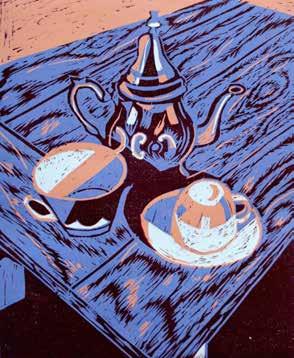
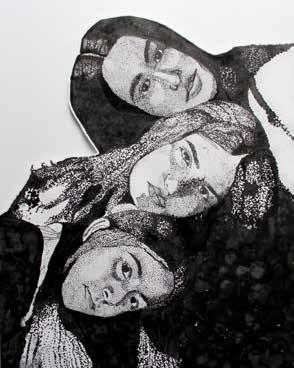

30 SWPS artwork
Leena MacNicol (Year 11)
Ashbury Warnes (Year 11)
Gia Sandhu (Year 11)
Serenna Copsey (Year 11)
Amina Ahmad (Year 11)



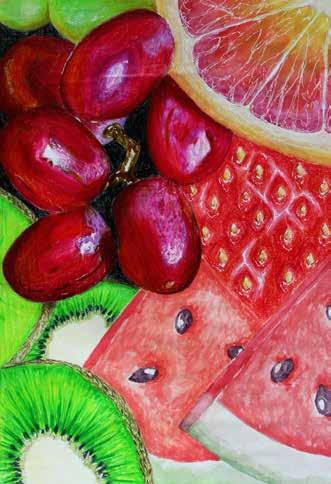
SWPS 31
Amy Li (Year 11)
Miah Anton (Year 11)
Diya Hothi (Year 11)
Anisha Naidoo (Year 11)
CLASSIC TRACKS
If you wanted to build your own collection of vinyl albums, where would you start? Music lovers Lucy Anderson, Willow Hef erman and Larisa Oliver-Warman (Year 12) give us their reviews of the six classic albums they would choose

THE BEATLES – REVOLVER (1966)
For fans of: The Kinks, Pink Floyd, T. Rex

Revolver marks the beginning of The Beatles’ evolution from their previously 1960s' pop-rock genre into a new period of psychedelic rock, heavily influenced by the musical, cultural, and artistic development of the time. Harrison’s burgeoning influence on their music is shown clearly in the sitar-heavy tracks, Love You To and Tomorrow Never Knows, which reflect his six-week period spent in India, while McCartney’s Here, There and Everywhere represents his attempt at matching The Beach Boys’ God Only Knows, clear through the harmonies he and Lennon construct in the opening lines of the track. Revolver also arguably captures Lennon and McCartney at the peak of their songwriting prowess,
with the album demonstrating an ambitious yet cohesive combination of numerous di erent genres which establish a significant turning point in the band’s discography.
THE DOORS – L.A. WOMAN (1971)
For fans of: The Rolling Stones, Je erson Airplane, Led Zeppelin
L.A Woman is an incredible album built up of deep blues, soft rock, while subtly keeping The Doors iconic keyboard sound. Jim Morrison’s poetic lyrics has a deeply sad undertone throughout. The lyrics describe the falseness Morrison believed to be shown within Hollywood and show the loneliness it really holds as opposed to the supposed excitement. The band evolve from their previous album (Morrison Hotel)
music

adding to the melancholy, the album is probably one of their most solemn which is fitting as it was the last album they made together before Morrison died later the same year. Although most of the album contemplates L’America and its reality behind the mask, Riders On The Storm discusses how little we are prepared for life and how little we really know about the world.
MAZZY STAR – SO TONIGHT THAT I MIGHT SEE (1993)
For fans of: The Sundays, Lana Del Ray, PJ Harvey Mazzy Star’s second album So Tonight That I Might See is a series of ethereal, hypnotic tracks distinguished by slide guitar, tambourine and Sandoval’s other-worldly vocals. The most well-known song on the album is Fade Into You which is both mournful and hopeful, and leaves a lasting impact on the listener due to its haunting reverb and beautiful lyrics. This album is perfect for relaxation as it creates a languid, peaceful atmosphere.
BELLE AND SEBASTIAN – THE BOY WITH THE ARAB STRAP (1998)
For fans of: Sufjan Stevens, The Velvet Underground, Matt Maltese
On their third album, The Boy With the Arab Strap Belle and Sebastian seem to maintain their charming sound from their previous album, If You’re Feeling Sinister, yet also introduce some darker themes into Stuart Murdoch’s songwriting which deftly combine with his dexterous wit and nostalgic, lyrical narratives. The title track of the album remains one of their most memorable songs, while Sleep the Clock Around has a distinctive and dreamlike structure, beginning with long synthesiser notes beneath the opening vocals and ending optimistically yet not over-sentimentally with trumpets and bagpipes. Cheery strings in songs like Ease Your Feet in the Sea and spoken lyrics in Dirty Dream Number Two also evoke the sounds of early The Velvet Underground, while the quietly confident closing track, The Rollercoaster Ride present an array of summery, and yet unexpectedly melancholy, songs which epitomises the characteristics of the chamber pop genre and challenge the band’s lighthearted twee image.




[his] knees and a wobble in [his] walk. He also sings about the struggles and toxicity of relationships which is emphasised by the passionate guitar playing throughout the album. Blunderbuss is intoxicating in the sense that it will fill you with the urge to dance.
BEABADOOBEE – BEATOPIA (2022)
For fans of: Clairo, Alex G, The Smashing Pumpkins
JACK WHITE – BLUNDERBUSS (2012)
For fans of: The Black Keys, Cage the Elephant, The Strokes
Blunderbuss is an energetic and exciting album filled with groovy rock guitar solos and White’s extremely recognisable voice rings through in every song. Blunderbuss has an undertone of the struggle to find love but also the way it makes you feel once it’s found which is depicted in, I’m shakin’, a cover of the Little Willie John song, when White talks about the girl that
Inspired by her childhood world and indie pop-rock of the 90s, Beatopia is a nostalgic mix of grungy guitar, melodic shoegaze, and dreamy vocals. The album's title comes from the name of an imaginary world Bea made up as a child, which was mocked by her teachers and classmates. In rediscovering her childhood world, she explores self-acceptance and frees her imagination. The songs range from the scuzzy guitar and catchy hooks of Talk and 10:36, to the reflective lyrics and wistful strings in Ripples and Lovesong. Her favourite song on the album is See You Soon which encapsulates the whole record in one song and feels euphoric to hear in concert as it fills the room with its dreamy instrumentals. You can hear the influence of her labelmates Matty Healy and George Daniel of The 1975, on songs such as the opening Beatopia Cultsong which echoes the 1975s self-titled signature openings Beatopia is a favourite album of ours because it immerses you into a dream world of soft, comforting nostalgia and grungy poprock inspired bops.
SWPS 33
OBJECTLESSON
Debbie Picton, our new Head, talks to Eve Leyland and Maya Daniel (Year 12) about a few of her favourite things
Bacchae by Euripides
As a classicist, books have always been important to me. This particular edition of Bacchae is especially important to me as it is the translation of the version I went to see at the National Theatre many years ago. I studied classics at Oxford university, without having studied it at A Level, and once I arrived, I had to get up to A Level standard pretty quickly! After that, I finally got to study some texts, and this was the first one I worked on. Bacchae is a morbid tragedy, and it has some really shocking grim themes in it about the human condition, conflict between religion and the state and identity - all manner of things! I loved it and thought it was a really engaging play to study, but I think the reason I like this edition so much is because it’s the most accessible version I’ve ever seen. Seeing such a modern translation, for me as a classicist, was wonderful because you get this sense that classics is for anyone as the themes are so relevant today. There’s always another way of looking at classics, or another way of interpreting a particular text or drama. I think this book brilliantly wraps up classics and I love when people do new things with old texts.
Thank You Card
This item holds lots of sentimental value to me. I keep it on my notice board. It is a thank you card I received from a pupil six or seven years ago and is an object that I have kept and cherish. This particular student wrote about an interaction where I had said something which to me was seemingly insignificant but to her it had meant a lot, and she wrote in the card what that meant to her. As a teacher, when you work with young people in a school, everything you say has the potential to have an impact on someone, even if to you it is a meaningless moment. This is always on my mind; to me the card is a really nice reminder of why I pursued a career in teaching and the importance which you have as a teacher on those you encounter every day.
Photograph of Blackpool Tower
I am from Blackpool originally and at home I have a black and white picture on my kitchen wall of the Blackpool Tower. This is really meaningful for a couple of reasons. Firstly, it was a wedding present from one of my best friends; she and I met in our first
week at Oxford, where we bonded over the fact we both had northern accents and felt very out of place. We have been friends ever since and as this photo is a really nice memento. Secondly, the photo reminds me of one of my first jobs as a teenager which was being a waitress in a café on the promenade in Blackpool, which was not a job I particularly enjoyed! So, having this photo on my wall not only reminds me of my roots, friendship and my wedding, but also that I am hugely lucky to have a job that I love and a profession that I really believe has meaning. So many people in life aren’t that lucky so it’s a nice reminder, on those tough days, to enjoy what I have.
My Headphones
I have always been someone who has loved music, although I am sadly not a musician myself; I wish I were. I find listening music a really good way of relaxing. About 12 years ago I was really unlucky and had an illness that meant I lost my hearing almost totally in one ear. This meant for a number of years I didn’t really listen to music anymore as it didn’t sound the same. Then not long ago I found these headphones which are brilliant for accessibility, and you can adjust the audio volume on each side which has made listening to music far better. They are an item that I cherish due to what they have given back to me.
French Music
Linking on for my love for music and regaining this through my headphones, I also listen to a wide variety of music. My favourite genre of music is French pop/ folk music. Both my husband and I took French A Level; he is a French teacher so almost fluent. As a family, we love France, and we go there most summer holidays.
Meeple
I absolutely love board games. Meeple are the little wooden characters that you find in many di erent board games with varying complexities. I feel Meeple o er an insight into my geeky hobby of board gaming! We play lots as a family, but we struggle to find ones we can all cope with, which I’m sure you can identify with, what with sibling rows and such. I think we have over 140 board games as a family. It is even
34 SWPS
feature
reaching a stage where they may need their own room!
SWPS 35

physical education
SPORTS DAY
Exciting moments from our annual Sports Day, which this year was won by Quant House. Pictures by Siona Mistry (Year 12) and Ian Russell (Head of Art & Design)

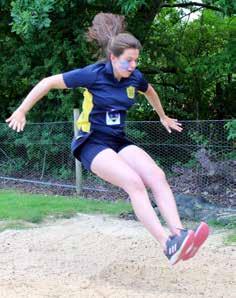



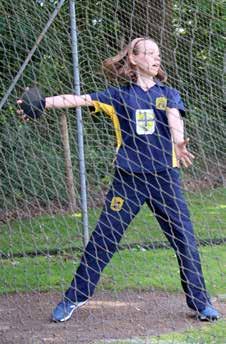
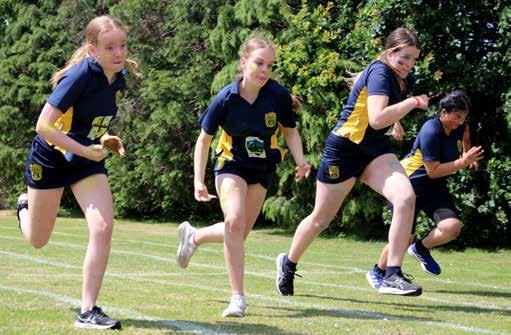






38 SWPS artwork
Milly Wee (Year 13)
Above: Ava Grant (Year 13)
Left: Emily Fletcher (Year 12)
Right: Siona Mistry (Year 12)

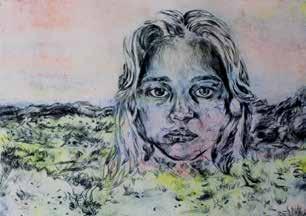

 Anna Cowell (Year 13)
Lucy Anderson (Year 12)
Anna Cowell (Year 13)
Lucy Anderson (Year 12)

THE BABRAHAM RESEARCH INSTITUTE

IN MARCH, FIVE YEAR 12 BIOLOGISTS ATTENDED THE BABRAHAM RESEARCH INSTITUTE’S SCHOOLS’ DAY IN CAMBRIDGE TO LEARN MORE ABOUT THE CURRENT BIOSCIENCE RESEARCH THAT IS TAKING PLACE THERE.
ASHANI PATEL
My practical project was “how to build a complex organism” and detecting mutations in DNA. We started by observing fruit flies with genes displaying di erent phenotypes and mutations of those genes. Physical characteristics I saw under microscopes included wings and eye colour. We also saw how GFP (green fluorescent protein) can be used to observe which proteins are present and which aren’t due to mutation. The second part of the practical activity involved extracting the specific genes we saw in the phenotypes from the DNA in the cell nucleus. The number of copies of the genes are then replicated by PCR (polymerase chain reactions) to amplify the regions of interest. We then used a process called DNA electrophoresis to separate the di erent types of genes based on their size (number of base pairs) and their negative charge.
BETHAN MARTIN
At the Babraham Institute, I chose the practical project of Scanning Electron Microscope (SEM) imaging. We prepared our eyebrow hairs by soaking them in acetone, placing them on sticky carbon dots, then transferring them to the sputter coater for a 5nm layer of platinum. Using the SEM you could see cells pushed and packed together to form the eyebrow hair. The hair shaft gave an indication of hair health and we compared the e ect of makeup and dead skin build up. We then viewed other samples including: face masks (the reusable one was worst, the N95/FFP2 mask, consisting of five layers with smaller gaps, the most e ective); blue cheese (you could see bacteria and fungal spores with hyphae) and a mosquito’s compound eye. Overall, I loved the experience and was thrilled to use a SEM myself.
EVE LEYLAND
I conducted a project entitled: “Working with worms – a model organism for ageing and disease” where I studied protein aggregation in a type of transparent nematode (worm) called C. Elegans. I compared the distribution of the PAB-1 protein (that is known to accumulate with age) in those that were 3 and 10 days old, using a technique called fluorescence microscopy. As ageing occurs, the ability of protein synthesis and folding deteriorates, which can cause deposits of insoluble protein clumps. By studying the intensity and location of these aggregates with the help of a red fluorescent tag, we could determine the approximate age of the worms. I thoroughly enjoyed the day; it raised many questions about what underpins neurodegenerative and other age-related diseases on a molecular basis and subsequently about their ability to be prevented or managed with therapeutic treatments.
SIONA MISTRY
At the Babraham’s Institute, I chose the gene targeting facility which performs research primarily on mouse embryos. Gene targeting, using CRISPR technology, allows us to create genetically modified (GM) organisms that can perform a useful function or express a specific phenotype. We produced solutions used to edit the DNA using Cas-9 proteins and di erent SgRNA proteins which we then injected into embryos with micro-needles. The embryos would then be implanted into a surrogate mother and the GM mice would be born. To analyse the genome, we used a PCR (polymerase chain reaction) machine to determine which genomes have been taken away, replaced, or added in the GM mice. I really enjoyed this practical project as it helped me to learn about the potential of genetic medicine and furthered my interest into veterinary medicine.
science
40 SWPS
MY VETERINARY MEDICINE PLACEMENT
Siona Mistry (Year 12) describes her lambing experience at a local sheep farm.
In March 2023, I spent five days at a sheep farm doing lambing work experience which I thoroughly enjoyed. In the short time I was there, I learnt so much and hugely improved my confidence around livestock. If you had asked me before this what I was most interested in specialising in at veterinary school, I would have completely overlooked being a farm vet. After my placement, this has become one of my main interests which really stresses the importance of work experience.
In the mornings, we would give the orphan lambs their first bottle or bucket feed; these lambs were orphaned from their mothers because they were born in triplets and an ewe can only properly feed two by herself. Feeding the lambs was one of my favourite tasks- although it took a while to master!
Then we would bed up the pens with fresh straw to prevent E. coli, one of the most common fatal diseases for young lambs, and top up hay and water. Every so often, we would make sure to check the polytunnel next door, home to around 100 pregnant ewes, for any signs of a ewes in labour (lambing). The key signs of lambing we had to look out for were nesting in the straw, a waterbag, clear discomfort and ‘stargazing’ where the ewe would lay down and look towards the sky while she pushes.
I had so many amazing experiences: putting iodine on the lamb’s navel to help it heal; banding lambs’ tails (putting on a special rubber band which will slowly remove the lamb’s tail to prevent blowfly); herding pregnant sheep; injecting a lamb with possible pneumonia with steroids and a sheep with penicillin and even helping pull out a lamb during an assisted lambing. I also had to run over a few times to break the water bag that lambs are born in, to prevent su ocation.



When recalling and reflecting on what I learnt, I recognised the importance of teamwork and cooperation during busy times like this on the farm and acquired a strong attention to detail. I was often left with two other girls to manage the lambing, a huge position of responsibility given the risks that newborn lambs can face, all of which gave me a taste of the duty I would have as a vet.
My placement encouraged me even more to pursue a career in veterinary medicine and further by love for animals- especially lambs!

SWPS 41
science

The addictiveness of dif erent types of drugs and the importance of stereochemistry
Words
by Jessica Wilkes (Year 12)
Artwork by Ashbury Warnes (Year 11)
There are many di erent types of drugs including agonists (stimulants), antagonists (depressants), hallucinogens and pain killers. They can all act on the synapses in one of three ways: blocking neurotransmitter receptors, stopping the reabsorption of neurotransmitter and by destroying enzymes.
Drugs that block neurotransmitters (antagonists), prevent hormones in the body from being able to bind to the receptors, thus stopping their e ect. An example of this is beta blockers as they prevent adrenalin binding to receptors causing a decrease in heart rate and anxiety felt by the person. These drugs are a similar size and shape to natural transmitters in the body, therefore, are able to bind to the body’s receptors where the natural transmitter does, preventing the receptor from producing a desired response. These drugs stop the action or e ect of other substances; therefore, they aren’t addictive themselves as they do not trigger the huge release of dopamine that agonistic drugs trigger. However, the a ect they have on the body from the substances they block can be addictive. For example, ca eine is a mildly addictive antagonistic drug that blocks adenosine receptors in the brain, causing people to be more alert and awake, an e ect that people can become dependent on especially in the mornings.
Drugs that prevent the reabsorption of neurotransmitters by neurons are addictive as they increase the availability of the neurotransmitter. For example, heroin inhibits the reabsorption of endorphins, therefore, there will be more available in the body causing the high that is experienced. These drugs, that are also generally agonists, cause an amplification
at the synapse as they can attach on to and activate neurones much like natural transmitters, as they tend to mimic the e ects of naturally occurring transmitters. However, the drugs are unable to stimulate the receptors as much as natural transmitters and instead send abnormal signals, which can override circuits in the brain, for example, the reward circuit in the prefrontal cortex. These drugs also cause a reduction in threshold of excitation of post synaptic membranes meaning fewer excitatory postsynaptic potentials (EPSPs) are needed for an action potential to be fired o . EPSPs are depolarising and make the inside of the postsynaptic cell more positive meaning the membrane is brought closer to its threshold for firing o an action potential, increasing the possibility of more nerve transmissions occurring. The reduction in excitation of the membrane has been caused by the downregulation of receptors due to the overuse of the drug.
Many drugs stimulate downregulation of receptors, this is when the number of receptors in the synapses of nerves decrease due to repeated long-term use of an agonist drug. Physicochemical alterations of receptors due to the long-term use means that the e ect of the drug isn’t as powerful as it was before causing a desensitisation to the drug. There are now fewer receptors that receive the dopamine signals in the reward circuit, and every time the drug is taken further downregulation of receptors occurs. This results in very low levels of dopamine release with natural rewards, which means that the feeling of euphoria and a sense of achievement is hard to find without taking a synthetic drug.
Drugs that destroy enzymes stop neurones being able to constantly fire o action potentials. Without the enzymes, there is a build-up of substances that are usually broken


science
down by enzymes. For example, without acetylcholinesterase (enzyme), acetylcholine can’t be broken down into acetyl and choline causing a build-up of acetylcholine in the presynaptic bulb which can lead to convulsions and spasms. These drugs are typically dangerous, for example, many nerve gases are enzyme destroying which is shown by the lack of control people have over their bodies once exposed to these gases and the spasms they experience.
Many drugs also have one or many chiral carbon centres, when a carbon molecule is attached to four di erent atoms or groups. A chiral molecule is a molecule that is nonsuperimposable on its mirror image (it has a left-hand side and a right-hand side, which are also called enantiomers) and di erent chiral molecules have di erent e ects on the body.
A famous example of this is thalidomide which was a drug that was used to help cure morning sickness for pregnant women, and quickly became one of the biggest scandals in modern medicine. Thalidomide was introduced as a racemic mixture (the mixture contained 50/50 mixture of left and righthanded molecules), the problem with this was that the left- and right-handed molecule bound di erently with receptors in the body and therefore caused di erent e ects. The lefthanded molecule was an e ective relief for morning sickness in pregnant women. However, the right-handed molecule was toxic and caused damage to the unborn foetus, meaning many babies were born with brain defects or missing limbs. The right-handed molecule does this as it binds to and inactivates cereblon, which is an important protein required for limb development, causing the babies born to be underdeveloped. There are many other examples of marketed racemic drugs that are harmless, for example, aspirin and ibuprofen, with these drugs only one enantiomer (‘hand’) produces the desired e ect but the other doesn’t cause any harmful e ects, it is just ine ective. This means that when taking the racemic mixture of drugs, the dosage taken will be higher to make sure that enough of the active enantiomer has entered the body.

2 enantiomers (left-handed and right-handed molecule which are mirror images of each other).


The body is also highly stereospecific, meaning that most receptors will only bind with one of the enantiomers due to the di erence in arrangement of the molecule in 3D space. Furthermore, the way the drug is used by the body changes its e ects; if stereoisomeric drugs that are brought into the body through passive movements like di usion then the enantiomers will act similarly. It is when the stereoisomer binds to enzymes, receptors or a transporter system where a preference in which enantiomer is utilised by the body will be shown. This preference may entirely depend on the spatial configuration of the molecule that compliments the receptor, meaning on the whole only one enantiomer is used.
In conclusion, there are many di erent e ects that drugs have on the human body, whether it is the type of drug or the enantiomer of one. It is hard to predict the dangerous side e ects that drugs will have on us and how addicted will we get to them. Drugs can be used to help us, and other drugs are developed to do so but end up going wrong and others are made to experience highs and help the user escape life. Drugs are all around us and have many, uses but we still need to be aware and careful of how we use them. Understanding the chemistry behind them shows us both the benefits and potential dangers of drugs.

stereochemicals
Cl Cl C C H3C C2H5 C3H7 H7C3 C2H5 CH3
mirror line
your gut follow
Words by Lucy Beaumont (Year 13)
Artwork by Ben
Patten
(Year 13)
OUR VERY OWN ECOSYSTEM
We’ve all heard sayings such as “trust your gut” or the “gut instinct” but considering its significance on our everyday life, the gut is remarkably underrated. Our gut plays a huge role in our health and wellbeing yet seems to be underappreciated and only recently talked about more widely. If the health of our gut can influence mental health, obesity, food intolerances and more, we should be trying to better understand and care for it.
To put into perspective, the total area of our digestive system is around 40 times greater than the area of our own skin, so you can imagine how vast the number of microbes living there must be. In our whole body, our own cells are outnumbered by microbes 10 to 1, and they all play a part in keeping us healthy. There are over 100 trillion microbes in our gut (a substantial proportion being bacteria) weighing in at around 2kg and most of these bacteria call the large intestine home. Having a large and diverse number of bacteria in your intestine is crucial, as it means that bad bacteria that enters the system is outcompeted. The diversity of this biome contributes to a fit, stable immune system, so boosting this little ecosystem is a particularly beneficial. Probiotics deliver live bacteria or yeasts to the large intestine, for example: yoghurt, kimchi, and sourdough. They also deliver types of fibre to the large intestine which feeds the bacteria and helps them grow, for example: apples, oats, and leafy greens. Sadly, after gastronomical infections or antibiotics, your gut biodiversity is in the pits. Imagine the floor of the rainforest has been swept away; you could never expect that environment to thrive as usual. This would be an opportune time to consume probiotics, however you may also get help from a surprising saviour (unless you’ve had an appendicectomy). In fact, the appendix houses lots of good microbes that are safely stored away and could be supplied to the intestine to repopulate the gut and help along its recovery. Of course, the appendix isn't vital to our survival; made evident by almost 50,000 appendectomies being carried out annually in the UK alone, but the appendix is not as useless as we preconceive.
trust your gut
44 SWPS science
“ “
THE SECOND BRAIN
The brain is widely acknowledged as the control centre of our whole body. What isn’t acknowledged is that our gut also contains such a large and diverse network of nerves and is just as chemically complex, almost like a hidden sister brain. The vagus nerve is the most prominent connection from the gut to the brain and it has been shown that when tampering with this nerve using stimulation frequencies, humans can be made to feel comfortable or anxious. It has been shown that inflating a tiny balloon inside the gut causes an increase in activity in the part of the brain associated with negative emotions. It has also been shown that patients with irritable bowel syndrome have high rates of anxiety and depressive disorders. People may avoid eating or overeat when stressed and some people get hangry. Clearly our gut influences our moods and mental health.
Our feelings, particularly stress, can also influence our gut health. When the brain undergoes stress, it sends a signal for the gut to provide it with more energy. The gut willingly does so, saving energy on digestion or sometimes just getting rid of food, and as a result not as many nutrients are absorbed. This energy saving from the gut will lead to weaker gut walls due to the reduced blood supply and a thinner layer of mucous, causing a disrupted balance in microbes and a weaker immune system. Long term sacrifice is not suitable for the body and the gut is forced to send negative signals to the brain to prevent serious damage, which can cause fatigue and loss of appetite. Therefore, shortening periods of stress is beneficial and can allow the gut function to return to normal.
THE MICROBIOME HOLDS THE FUTURE
A recent and ongoing field of research is the gut microbiome; this is the collective genomes of the microbes in the gut. Once the technology was developed to unpack the human genome, it was discovered that there are only around 20,000-25,000 genes. That’s almost half that of the rice plant. These genes can only explain so much in the field of medicine, but what could take our understanding of many diseases and biological processes much further, is the research into the collective 4.4 million genes that make up the microbiome.
Evidently, caring for our microbes and gut is obviously crucial for a happy life and we can do this by eating a variety of foods and better managing our stress levels and emotions. Besides, a healthy gut is linked to healthy aging, and I know that I want to look fabulous at 90.
SWPS 45 micro biome

OVERTURNED
How has the church swayed?
Abortion was legalised in the USA in 1973 - now the Supreme Court has overturned that right.
Roe vs Wade was overturned in June 2022, e ectively making it possible for states in the USA to ban all abortions later than 12 weeks. Abortions are defined as the deliberate termination of a human pregnancy, most often performed during the first 28 weeks. The pregnancy is either ended by taking medicines or having a surgical procedure. Whilst abortion will not automatically become illegal in all states, individual states will have the power to decide how and if to allow abortions. Abortion is a divisive issue in American politics, with widely di erent abortion laws in US states. Since 1976, the Republican Party has generally sought to restrict abortion access whereas the Democratic Party has generally defended access to abortion and has made contraception easier to obtain.

Words by Elysia Maiden (Year 12)
ROE
The attorney representing Dallas County (a county within Texas) was named Henry Wade - therefore Roe vs Wade. Ms McCourvey was a single woman, pregnant with her third child and was claiming to have been raped when she filed her case: which was ultimately rejected, and she was forced to give birth. However, in 1973 her appeal made its way to the Supreme Court, alongside a case from a woman from Georgia, arguing abortion restrictions infringed on women's freedoms and right to privacy as stated in the US constitution under the 14th amendment.
What is Roe vs Wade? In 1969, a woman named Norma McCorvey (under the pseudonym Jane Roe) challenged the abortion laws in Texas which forbade abortion unless the mother’s life was in danger.
With a clear vote of seven to two, the court ruled it was a women's right to terminate her pregnancy. However, Roe vs Wade was overturned in 2022 after a period of tension surrounding the bill after President Trump nominated Justice Brett Kavanaugh for the Supreme Court, who was confirmed in in 2018. President Trump specifically chose Kavanaugh on the hopes he would overturn Roe vs Wade, despite initial statements from Kavanaugh denying this. Anxiety
: ROE WADE VS VS
religious
studies
46 SWPS
over Roe vs Wade increased even more with the passing of Justice Ruth Bader Ginsburg in 2020 as many pro-choice advocates worried that filling Ginsburg's seat with the conservative Justice Amy Coney Barrett put abortion rights in danger. In 2022 Justice Samuel Alito wrote that the 1973 decision was “egregiously wrong and on a collision course with the Constitution from the day it was decided” when delivering the conservative opinion of the court’s majority. Alito dismissed warnings of regulatory chaos that may arise if the abortion drug was suddenly withheld. Kavanaugh wrote a separate concurring statement “To be clear… the Court’s decision today does not outlaw abortion throughout the United States.” but without the mifepristone drug option, access to abortion will be significantly restricted in the USA.
Many Christian nationalists often claim the passing of Roe vs Wade was the turning point that led them to advocate against abortion. The most Christian states are situated in the Southwest and Southeast of the USA, known as the Bible belt. Most of these states have banned abortion already or abortion will likely be banned due to Roe vs Wade being overturned. This includes states such as Oklahoma, Tennessee, Mississippi, and Texas. Many traditional and conservative Churches within these states strongly support the ban on abortion, such as the North Texas Evangelical - Mercy Culture Church. Roe vs Wade was overturned on a Friday and on the Sunday, Pastor Landon Schott made it a central part of his sermon. This is due to some Christians belief that abortion is morally wrong as it can be interpreted as going against the 6th commandment - You shall not murder, and the idea that life may begin at conception. In the 12th century, St Thomas Aquinas developed natural moral law, still used today by the Catholic Church, and applied globally. Many arguments against abortion were developed from this ethical theory, as many Christians believe abortion
does not fulfil the primary precept (a never changing rule) of preserving life. Arguably, the conservative Christians election into political roles; with their ostensibly traditional Christian views has had a notable e ect on abortion legislation.
WADE
However, this is not a universally Christian view, as many other Christians would also argue they should not use religion to justify the ban on abortion as this goes against the teachings of Jesus. All Christians should follow the example of Jesus as he is God incarnate, Jesus’ example should influence Christian behaviours more than the ten commandments, as Jesus superseded the Law established in the Torah. Jesus taught the priority of love, empathy and forgiveness, and therefore many liberal Christians may be pro-choice. Liberal Christians believe that as Jesus respected women, but often the prolife discourse around abortion blames a woman; it would consequently be hypocritical to follow this discourse which ultimately disrespects and disregards women's rights.
Overall, it is clear that traditional conservative Christian views still have a significant e ect on American politics, especially when talking about abortion. However, this is not an accurate portrayal of all Christians in America, as clearly more liberal believers have begun to separate their faith from politics and focus on preaching Jesus’ message of love and empathy. Evidence suggests the majority Christian population in the USA has a ected and continues to sway political votes; often causing restrictions in individual's lives. But as global society has begun to put more of an emphasis on awareness and acceptance, many Christians are beginning to become more liberal and realise it is not just for their religion to be the reason behind restrictions in other people’s lives.

Artwork by Ava Grant (Year 13)

roe vs wade
Eve, Bethany, Tess and Natasha discuss what they enjoy most about dissection club
DIS SECTION

EVE SAZEN (YEAR 7)

CLUB
TESS SHOREY (YEAR 9)
When a friend first talked to me about dissection club, I wasn’t drawn to the idea. But after she convinced me to go, and we dissected an earth worm together, I was fascinated and was surprised when I was able to see its very small brain! I have come back every week since and the prefects have guided us through dissecting sheep hearts, liver, lungs and brains - you would be surprised at how small they are!
BETHANY BUNN (YEAR 8)
Due to my interest in biology, this was definitely at the top of my list of clubs to sign up for. I was inquisitive about what we would be dissecting and how we would do it. My favourite week was when we dissected a locust because it surprised me how many processes could be occurring in such a tiny body! Thanks to the amazing Sixth Formers who organise it, lots of my questions have been answered about biological dissection.
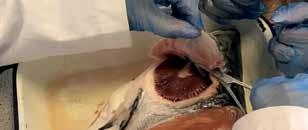
I have always had an interest in animals and wildlife. Having had many pets, I have come to see that the anatomy of each animal can never be the same: no organ is exactly the same in each. We dissect a range of di erent things, from a worm to a lamb’s brain. My personal favourite was the frog, with its protruding eyes and webbed feet, I was eager to see what was inside these amphibians. It was a great surprise when we cut open the frog to see soft jelly filled with eggs - frogspawn! After scooping out the eggs, we could finally inspect the insides.
NATASHA WALKER (YEAR 10)
For the past few years, I have been interested in the sciences and medicine, so I thought that dissection club would be a perfect way to further my understanding. The club has been so much fun this past term: we have dissected a locust, earthworm, sheep’s brain and a pig’s trotter! My favourite has been the pluck (the organs found in the chest cavity). In this dissection, we were shown the key features and were also given time to explore by ourselves so that we could navigate around the organs and ask questions about our findings. We were able to feel the di erent tissues and could visualise exactly how the organs connected, which will prove to be extremely helpful for my upcoming biology GCSE.
co-curricular
KATIE FORD
(Year 12) describes her journey to becoming a national swimmer
Istarted swimming when I was 6 years old. I had recently watched my sister training, and it inspired me to try it myself. I did a trial for a swimming club, and it would be an understatement to say I was excited. I loved it which is illustrated by the fact that I have been pursuing my passion in swimming for over a decade now. Over the years I have competed in countless competitions. In 2015, when I qualified for Counties, I believed this was the peak of my swimming career. Little did I know that only two years later, I would be qualifying for several events at Regionals. I continued competing at a regional level until March 2020, when the COVID-19 pandemic hit. This period of time, unable to train, majorly hindered my swimming career. I started o optimistically by running 5K every day, until I realised there was more I could be doing and started to create my very own home fitness routine.
After almost a year of not being in the pool, lockdown was finally lifted and I dived right back into training. Even though COVID was a rough patch for my swimming journey, after years of intense training and hours of hard work I finally achieved my dream in the summer of 2022 – when I qualified for multiple events, at my first National competition in She eld. I was slightly nervous entering the competition, yet full of excitement and a drive to succeed. I competed in 50m and 100m backstroke and I was overjoyed to see that the endless hours of training I had completed had finally paid o ; I placed 1st in 50m backstroke and 2nd in 100m backstroke, achieving lifetime bests in both.
My training requires me to attend over 8 water sessions a week and I also try to complete a minimum of two land sessions a week, which makes keeping up with my schoolwork very di cult at times. Thankfully, my family and coaches have been very supportive of me throughout the journey. I am currently trying to qualify for British competitions, although this is di cult as I am now in the open age group. My dream is to qualify for the Olympics, and I hope to make this dream a reality. I am so grateful for my

coach and family who have been my numberone supporters since day one and have always shown me that I can achieve anything.
I love swimming, and I am so thankful for the opportunities it has created for me in life.
SWPS 49 co-curricular
Something a lot of us at SWPS have in common is our experience of education. And how often do we moan about it? School life can be di cult, with homework, exams, and personal dramas. It easy to forget what a privilege education is. There are people our age who have lost this privilege, through no fault of their own.
In August, I spent a day with the Big Leaf Foundation at their summer school, at the University of Surrey. This programme provides support for displaced young people who often have little or no access to education in the UK. I had the opportunity to hear their stories and I began to understand how charities, community groups and agencies in the UK are supporting education for young people who have been forced to leave their homes.
Reuben, 17, El Salvador
Firstly, I spoke with Reuben a 17-year-old Sal El Salvador is a Spanish and Nahua-speaking country in Central America, known as the “Land of Volcanoes”. It is rich with culture and natural beauty, but it is also described by Médecins Sans Frontières as one of the world’s “most violent countries”.
According to the President of El Salvador, Nayib Bukele, around 80% of the country is under the
control of violent criminal gangs. In particular, the infamous rivalry between gangs MS-13 and Barrio 18 has hugely a ected the people of El Salvador, especially the education of young people. The United Nations Children’s Fund (UNICEF) found that in 2015 around 15,000 students dropped out of school that year due to gang threats. This figure is believed to have increased significantly since then.
I spoke with Reuben, a 17-year-old, who fled to the UK after the suburb where he lived was taken over by at least two rival gangs.
Reuben left home for school one morning as usual and saw that one gang had barricaded his street, with heavily armed men everywhere, preventing anyone from crossing into another area of the town. Since Reuben’s school was two miles away, his access to education came to a halt overnight. Soon after this, gang-members started knocking on doors, looking to forcibly recruit teenage boys. Reuben’s mother knew she had to protect him and his brother so, during the night, she helped them escape, knowing they may never come back. Currently, Reuben is waiting to be granted asylum in the UK and is living in one small, shared hotel room in Surrey. He and his brother rely on local charities for some partial schooling, but they can’t provide them with enough. Reuben has always wanted to be a doctor and needs to be in full-time education to achieve this.
perspective
By Jessame Cable (Year 12)
*The names of those interviewed for this article have been changed for safeguarding reasons
feature
another
another perspective
Katya, 19, Russia
Katya described to me how she has faced hostility as a result of the stand she took over the actions of President Putin, who invaded Ukraine in February 2022.
One day, Katya and her friends left school and, instead of going home, decided to attend an antiPutin protest nearby. Unfortunately, the police were waiting for the protesters, including Katya and her friends, who then found themselves under a surge of batons and tear gas, with bullets being fired over their heads. In Russia, under Putin’s government, any kind of protest against the government is a crime and can result in lengthy prison sentences. After being filmed protesting, Katya was branded a criminal, forcing her to flee overnight in order to avoid punishment.
Katya was one year away from finishing school, in the equivalent of Year 12, when she had to leave her home. She turned 18 shortly after arriving in the UK, which meant she didn’t get o ered a place in formal education. She told me that as a Russian, she was not given refugee status immediately and is terrified of being deported to Russia.
Katya has always wanted to be an engineer, but as now she is 19, it’s almost impossible for her to complete her education and get the A Levels she needs. She feels she doesn’t have a choice about what to do with her life anymore. Not only has her education been impacted, she has also been left in fear: afraid of the police and of what her future holds.
Khadia, 16, Afghanistan
Finally, I spoke to Khadija, a 16-year-old girl from Afghanistan. Khadija and her family came to the UK after the Taliban reclaimed control of Kabul in 2021. The Taliban is an extreme, ultraconservative political group, who follow a fundamentalist interpretation of Islam. Their regime has caused insurmountable harm in Afghanistan, particularly to women.
During the 2021 uprising, Khadija’s father was killed by the Taliban. Her mother took Khadija and her sisters to board an evacuation flight as the Taliban closed in, but they didn’t make it in time. To escape, they were forced to find their own way through Uzbekistan using lorries and boats. The journey was terrifying and dangerous, but Khadija said the thought of staying in Afghanistan scared them even more. Months after arriving in the UK, Khadija and her family are still waiting to be granted refugee status. Like Reuben and Katya, Khadija is yet to start school here.
When I described SWPS to Khadija, she was surprised at how much it reminded her of her own school. Khadija’s father was a doctor, and she was able to attend an excellent school. She recounted how she enjoyed maths, and captained the hockey team, although what Khadija misses the most about school is her friends. She hasn’t seen or heard from any of them in almost two years.
Khadija says after the Taliban took over in Afghanistan, girls’ schools were closed while schools for boys remained open. Currently, girls in primary school are being banned from learning. Khadija feels she is in a similar situation here in the UK because she has no right to an education and still isn’t able to go to school.
another another perspective
Access to an education is more of a privilege than we may think. Having it taken away creates uncertainty in the futures of young people and can be incredibly isolating. Being forced to move to a new country, where you can’t understand the language or rely on a support system would leave anyone feeling separated from society. Access to education is vital for young people to rebuild their lives, and more needs to be done to support them.
My conversations with Reuben, Katya and Khadija gave me an understanding of the many hardships other young people from around the world are living through right here, right now.
At SWPS we are very privileged in relation to the quality of our education. Access to education, though, should not be a privilege; it is a right. Ripping this away from young people harms their prospects and isolates them from the rest of society. School has a huge role to play in helping these young people rebuild their lives, find new friends, and become part of a community once again.
SWPS 51
modern languages

Les femmes francophones qui ont changé le monde
Zahra, Mia, Diya, Lily and Janna (Year 9) refect on some French-speaking women who helped change the
JEAN AUGUSTINE BY ZAHRA AHMED (YEAR 9)
Jean Augustine is a trailblazing French speaking Canadian politician who was born in the 1930s. She was the first Black Canadian woman elected to serve as a Member of Parliament. Augustine was a strong believer in supporting social organisations, such as The Hospital for Sick Children, the Stephan Lewis Foundation and the Harbourfront Corporation. She was also an advocate for education, social housing and for women and black rights.

Interestingly, Jean Augustine is one of the reasons Black History Month is celebrated annually in February in Canada, America and the UK. For her dedicated work over many decades, Jean Augustine has been honoured with multiple awards such as the the Order of Ontario and the Order of Canada “for her distinguished career as an educator, politician and advocate for social justice in Canada”. Indeed, her impact lives on as she is still working towards an unbiased and equal Canada where young people are inspired to pursue their passions.

Portrait of George Sand, which hangs at Chawton House, Jean-Baptiste, 1847
GEORGE SAND BY MIA DARLING (YEAR 9)
George Sand was a French novelist, journalist and memoirist. She was born in Paris in 1804. Even though most French citizens and readers know her as the writer George Sand, her actual name was Amantine Lucile Aurore Dupin de Francueil. She was known for her unconventional dress as she wore men’s clothing without a permit – something that was unheard of in the nineteenth century. Sand changed her name to sow confusion about her identity and to increase her chances of becoming published and being successful. Sand was also one of the first people to advocate and speak out for women’s rights in France. She openly challenged the traditional roles assigned to women and shone the spotlight on their secondary roles in society. Her writings also explored the themes of gender equality which was a challenging topic to cover in the nineteenth century. Even today George Sand is celebrated as one of the greatest women political activists in France. Her work continues to inspire writers and reminds us of not only the struggles that came with being a woman in a previously unchanged society, but also the beauty in the romance and realism of her e ortlessly spontaneous writing.
52 SWPS
les femmes francophones
SIMONE VEIL
BY
DIYA PATEL (YEAR 9)
Simone Veil’s legacy is one of courage and resilience in the face of adversity. Born in the late 1920s, she was the youngest of four children in a Jewish family. Veil’s family was deported to a concentration camp in Germany and Simone and her sister were the only survivors. Veil drew strength from her di culties and became a magistrate, then the government minister for Health. In 1974, she worked tirelessly to legalise abortion for women in France, despite the significant opposition to her cause. She courageously held her position and the law, known as the ‘Loi Veil’, was passed. Veil went on to become the first woman to hold the position of President of the European Parliament.
She passed away in June 2017 at the age of 89. She will forever be remembered as a strong advocate for women’s rights, gender equality and as an outspoken opponent of racism and antisemitism.
FUMILAYO RANSOME-KUTI
BY LILLY
RAKOVAN
(YEAR 9)
Fumilayo Ransome-Kuti was a Nigerian feminist, activist and politician. She was a key figure in the Nigerian independence movement, who worked alongside her husband, Reverend Israel Oludotun Ransome-Kuti, to fight for the freedom of Nigeria from the British Colonial rule. As well as her strong activism, she was a politician who served in the Nigerian House of Representatives and the first woman to serve in Nigeria’s West Region House of Chiefs. Ransome-Kuti was Nigeria’s very first representative at a women’s international conference in the USSR in 1963; she was also Nigeria’s first woman to drive a car and ride a motorcycle. Ransome-Kuti received the national honour of membership in the Order of the Niger in 1965 and the Lenin Peace Prize in 1970 for all her dedication and highly regarded work as a women’s right’s activist and educator.


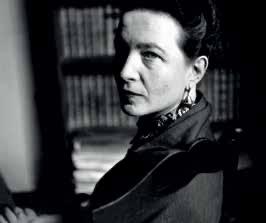
SIMONE DE BEAUVOIR BY JANNA TAGELDIN (YEAR 9)
Born in 1908 in Paris, Simone de Beauvoir was a French existentialist philosopher, writer, social theorist, and feminist activist. She influenced both feminist existentialism and feminist theory. Beauvoir published her first novel She Came to Stay in 1943; her most well known was The Second Sex, which was first published in 1949, and in which she discussed the treatment of women in the present society, as well as throughout all of history. Her second contribution to the feminist movement was a petition, entitled Manifesto of the 343, which she authored and signed in 1971; this paved the way for the legalization of birth control and abortion in France. Simone de Beauvoir’s book, petition, and willingness to fight for gender equality changed the face of feminism and society at the time.


SWPS 53
Portrait of Simone Veil via Getty Images
Portraits of Simone de Beauvoir via Getty Images
economics
Words by Elysia Maiden (Year 12)


£ -of -living crisis what is the cost ?
Since 2021 the UK has faced an economic situation, deemed ‘the cost-of-living crisis’. Stated simply, this is a scenario in which the cost of everyday essentials is rising much faster than average incomes in this country. The crisis is believed to have been caused by various factors a ecting inflation in the UK including Brexit, the COVID-19 pandemic and the Russia-Ukraine war. Whilst everyone in the UK has been a ected by the rising prices of many essential goods, such as food, it is disproportionately a ecting low-income households.
A specific industry being heavily criticised and monitored regarding their strategy of dealing with the outcomes of the current economic situation is the supermarkets. Many of the products sold within supermarkets, such as food and drink, have an inelastic PED (Price Elasticity of Demand), which means demand for these types of products will not drastically change regardless of prices rising. As costs increase for everyone, firms are put under pressure by their workforce to increase wages, creating a further need for prices to rise to cover these costs. Giant
supermarket chains in Britain, such as Sainsbury’s or Tesco’s, are currently finding that consumers are showing remarkable capacity to maintain high demand for goods despite price increases. In April 2023 ‘The Sunday Times’ reported that food inflation hit 19.2% in March which is the highest it has been in 45 years, but the e ect of inflation is a ecting consumers far more than suppliers and retailers.
An analyst, Martin Deboo, at the investment bank, Je eries, shows that price increases pushed through companies are disproportionately high compared to the prices they pay for resources, for example, Unilever’s prices (a British multinational consumer goods company, products including condiments, bottled water and baby food etc) last year were 31% greater than the increase in its costs of goods. This clearly suggests that some large companies are taking advantage of customers perceptions of rising costs and inflating the prices of the products past what is needed to cover their costs and therefore potentially profiteering from consumers: this will have a regressive e ect on lower income households. Current higher energy prices are a ecting the poorest
54 SWPS
cost- of- living crisis
20% of the population feel inflation 1.8 times more than the richest 10% in the country. Deboo’s analysis also shows that price rise by Reckitt (a producer of health, hygiene and nutrition products) were more than double the increase in its costs, further cementing the analysis that some large corporations are taking advantage of customers during the costof-living crisis. Consumer group Which? said the price of some goods jumped by as much as 25% in April compared to the same month last year. Dairy goods such as cheese saw the biggest rise, said Which? Overall, in a survey of the UK's eight largest supermarkets looking at 26,000 products, it said food prices rose more than 17%. It also found supermarket own-label budget items were up 25% in April compared with the same period 12 months ago.

A specific food market sector example to explore where inflation is being driven by companies boosting their own profit margins rather than by demand exceeding supply is milk. Data suggests supermarkets have been making abnormally large margins on milk for months at the expense of their customers. The average di erence between the farm gate price of milk and the shelf price of milk peaked at 42 pence a litre in February 2023 compared with an average of 35 pence over the previous decade. Michael Oakes, chairman of the dairy board at the National Farmers Union, believes that “Supermarkets don't care how expensive the milk is as long as they're all in line with each other”. I believe this possibly alludes to the idea that supermarkets may be colluding and price fixing in order to boost profits, on top of covering the increase in fixed costs due to the current cost of living crisis. This is technically illegal and viewed as anti-competitive behaviour by the CMA (Competition and Markets Authority) which is discouraged due to the negative e ects on customers. Sir Ed Davey, the Liberal Democrat leader, calls on the governments to examine whether retailers have been profiteering during the cost-of-living crisis. “If you push up prices when inflation is low and stable people won't wear it... But when you've got lots of inflation and prices are all over the place it's very di cult for anyone to actually get a handle on what the correct price is. If supermarkets continue to function this way throughout the cost-of-living crisis it seems this will cause inflation and price rises to continue perpetuating the financial struggle many people within the UK are currently facing. The BBC reported in mid-May this year that the CMA said it would look at whether a "failure in competition" meant customers were overpaying for fuel & food. Supermarkets responded to questions that they were working to keep food prices "as low as possible". CMA chief executive Sarah Cardell said the watchdog was "stepping up our work in the grocery sector to help ensure competition is working well and people can exercise choice with confidence".



 Artwork
by Anna Cowell (Year 13)
Artwork
by Anna Cowell (Year 13)
MR PEEL’S LEGACY
Eve Leyland (Year 12) spoke to Mr Peel about his time and memories from SWPS

What is your most memorable moment from your time teaching at SWPS?
What I shall remember most are those random and spontaneous outbursts of whole school loveliness, most commonly expressed as an “Aww”, when a speaker said or showed something sweet. I also used to feel that the Variety Show most encapsulated the spirit of SWPS, in which dances hastily choreographed on the grass at lunchtime, younger students coached by older students, turned into AMAZING themed and costumed musical tours de force, alongside more individual performances of equal brilliance, and all within a supportive but also ultra-competitive (and deafening) atmosphere.
Do you have a favourite school trip which you went on?
When did you decide you wanted to pursue a career in teaching and what inspired you to do so?
Both my parents were teachers, and I loved Classics so much at school that I decided to be a Classics teacher when I was in Year 9. But when I finished my 4-year Classics course at Oxford, I felt I needed a break from school and study. I then got sucked into a di erent (much higher-paying!) life for 20 years and it was di cult to leave behind. But my vocation to teach Classics would not leave me alone, so I started to apply for teaching jobs in 2009, and landed one at Reed’s School. After 3 years there, I came to SWPS to be Head of Classics in 2012.
Do you remember what your frst day was like at SWPS?
My first impression of SWPS was two di erent Year 7 classes on a Thursday afternoon, and I was amazed and delighted by their energy, their sense of fun, their imagination, and how hard they worked. I knew instantly I was going to love it here, and so it proved, every year for 10 years. I used to say to prospective parents that SWPS performed an annual magic trick, in finding and selecting 96 clever, funny and kind students to delight their teachers and make the school a wonderful place to study and work.
I was very proud to lead SWPS’ largest ever foreign trip, of 100 students, to the Bay of Naples and Venice. To see such a large crowd of us racing across Lake Garda in a flotilla of speedboats, then cruising the canals of Venice in elegant gondolas was properly spectacular, and I enjoyed doing whole-restaurant SWPS takeovers every night too. I enjoyed every Classics trip though, and a truly fascinating History trip to Berlin with Mr Jones, not least because I was SO proud of the young people I was with, so relaxed due to their wonderful manners and behaviour, and so well supported by the lovely colleagues, and mums, who came on the trips too.
What is something which you will miss most about the school?
I will certainly miss lots of helpful and lovely colleagues who were such fun to hang out with at lunch and in the common room, and even occasionally in the pub. What I will miss most however are those cohorts of driven, clever, funny and kind young women who were so much fun to teach and so energising and inspiring to be around. I was really proud to say I taught at a girls’ school, and hugely motivated by that to do my best to support you and prepare you for a world which still puts sexist barriers in your way.
If you could ofer one piece of advice to students at SWPS what would it be?
My most motivating mission at SWPS was to try to make sure you could see your own brilliance, which was so obvious to me. My advice to you all is to develop a life-long habit of aiming for the best and most senior prizes and positions. You deserve them, and must expect them. I want you to run the world, because if you do not, less able people will, and then we are all in trouble.
I want you to run the world, because if you do not, less able people will, and then we are all in trouble.
feature
“ “
food technology
catalan meatballs à la Mme Cooper


ingredients instructions
750g well-seasoned sausage meat
250g minced beef
1 large onion
5 cloves of garlic
2 tablespoons of plain white flour
170g tomato puree
1 bag of dried porcini mushrooms
6 large potatoes
300g button mushrooms
1 jar of pitted green olives
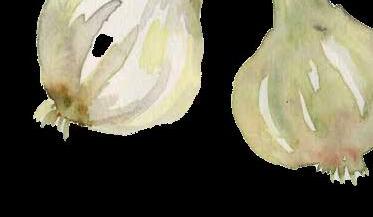
Mix the sausage meat and mince together and make balls with the mixture (roughly the size of the palm of your hand). Lightly coat the meatballs with some of the flour.
In a large casserole dish, brown the meatballs in oil or butter. Remove the them when they are golden brown. Set aside.


Chop the onion and garlic and cook them in the same oil and casserole dish as the meatballs. When the onion and garlic are cooked, add the tomato puree, the rest of the flour, and some water – what looks like enough to almost cover the meat once it’s added. Mix well and then add the meatballs to the sauce.
Leave to simmer for 30 to 40 minutes. In the meantime, pour warm water on the dried mushrooms to hydrate them. Add the button mushrooms and potatoes in the dish and leave to simmer until the potatoes are cooked.
At the end, add the porcini mushrooms and the olives. Salt and pepper to your taste. Enjoy!


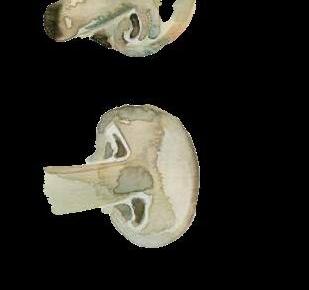
 Artwork
by Lizzie Sevenoaks
Artwork
by Lizzie Sevenoaks



artwork
Willow He erman (Year 12)
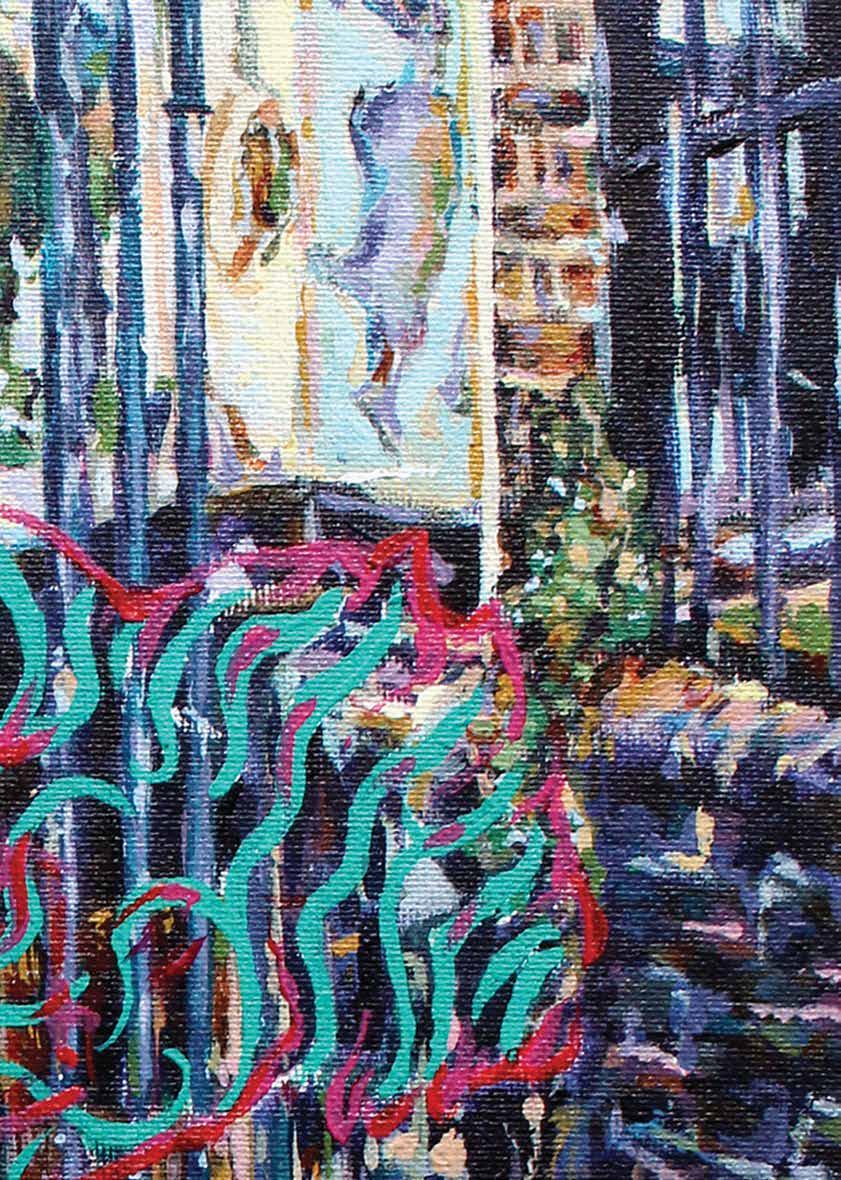

Sir William Perkins’s School Guildford Road, Chertsey, Surrey KT16 9BN T 01932 574900 E ofce@swps.org.uk www.swps.org.uk


 Cover by Serenna Copsey
Cover by Serenna Copsey




























 Words by Bethan Martin (Year
Words by Bethan Martin (Year



 Artwork by Ashury Warnes
Artwork by Ashury Warnes












 Vietnam by Ashbury Warnes (Year 11)
Vietnam by Ashbury Warnes (Year 11)


 Top left: Isle of Wight by Emily Richards (Year 9). Top right: Puy-l'Évêque, France by Katie McCummiskey (Year 9)
Above: Lake Moraine, Alberta, Canada by Isabelle Franklin-Moseley (Year 7)
Top left: Isle of Wight by Emily Richards (Year 9). Top right: Puy-l'Évêque, France by Katie McCummiskey (Year 9)
Above: Lake Moraine, Alberta, Canada by Isabelle Franklin-Moseley (Year 7)


 Top: Lysebotn, Norway by Bella Chen (Year 10)
This picture: Brecon Beacons, Wales by Sienna Balderson (Year 10)
Top: Lysebotn, Norway by Bella Chen (Year 10)
This picture: Brecon Beacons, Wales by Sienna Balderson (Year 10)



 Top left: Printemps Penthouse, Paris by Madison Fordyce (Year 12)
Top right: Trebah Gardens, Falmouth by Akriti Simha (Year 11)
Middle right: Polyapes Campsite, Cobham, Surrey by Katie McCummiskey (Year 9)
Top left: Printemps Penthouse, Paris by Madison Fordyce (Year 12)
Top right: Trebah Gardens, Falmouth by Akriti Simha (Year 11)
Middle right: Polyapes Campsite, Cobham, Surrey by Katie McCummiskey (Year 9)










































 Anna Cowell (Year 13)
Lucy Anderson (Year 12)
Anna Cowell (Year 13)
Lucy Anderson (Year 12)


































 Artwork
by Anna Cowell (Year 13)
Artwork
by Anna Cowell (Year 13)









 Artwork
by Lizzie Sevenoaks
Artwork
by Lizzie Sevenoaks




